November 14
Last day in Singapore was a full and tiring one, the latter due in part to it being the end of a long trip, in part to a lot of running around and in part to the hot, humid weather. Best aspect was the chance to spend a lot more time with Rinpoche.
Breakfast at the hotel with Antonio Eraso, a Singaporean architect who I’d met and spent some time with on my second visit to Bhutan, when he was planning to do a major renovation of Rinpoche’s monastery, which has not taken place. Antonio is in and out of Singapore a good deal in his work, and describes Singapore as a kind of aircraft carrier for him. Rinpoche joined us for the second half of the breakfast, but then had to leave for a meeting.
I walked to see the Jewish synagogue, which serves about 500 people. The building is gated and there is a sign that says no admittance, but when I asked to go in, the guard asked where I was from, whether I was Jewish, inspected my passport and let me in. I was shown around by another guard, who told me about the synagogue, which was founded by an Iraqi Jew. (Note: my Singapore photos are clearly a reversion to snapshots that document the trip. Time and conditions didn’t allow for much more, and I was pretty-much photographed out after taking well over 3000 in China.)
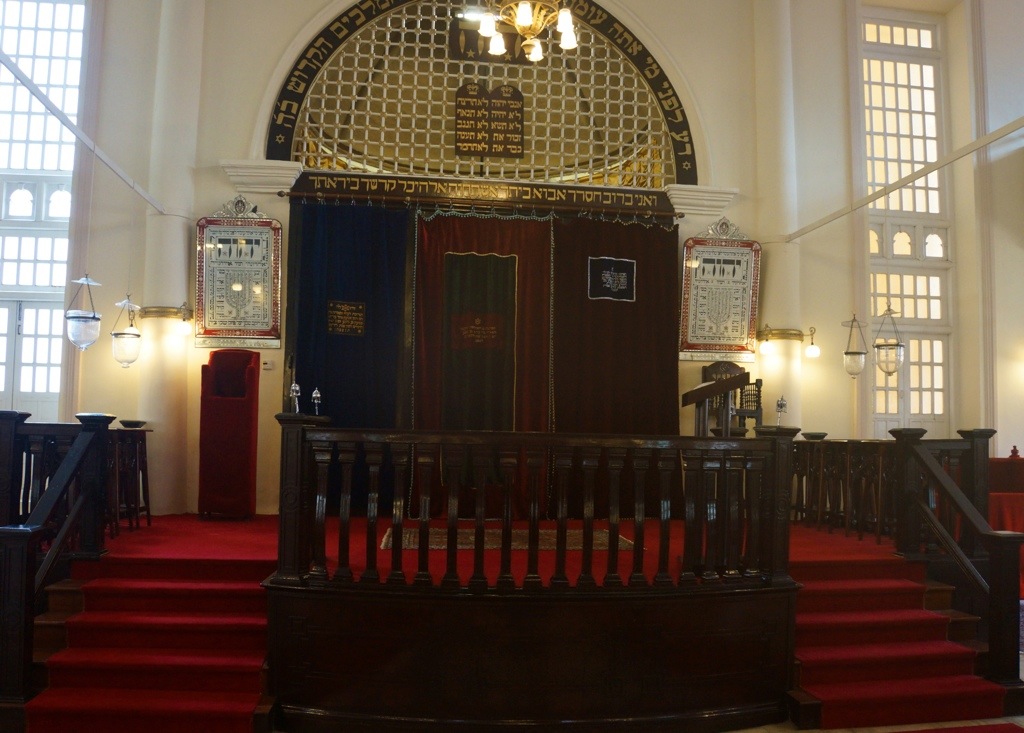
Walked farther down the same street to see the bustling Chinese Buddhist and Indian Hindu temples, both of which were crowded with worshippers.
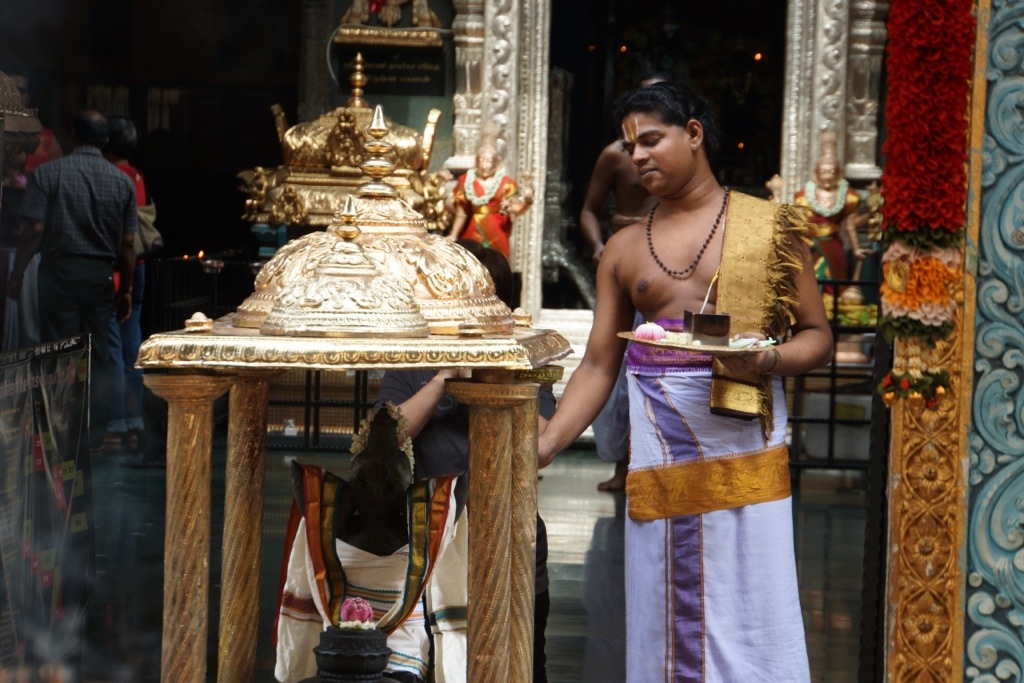
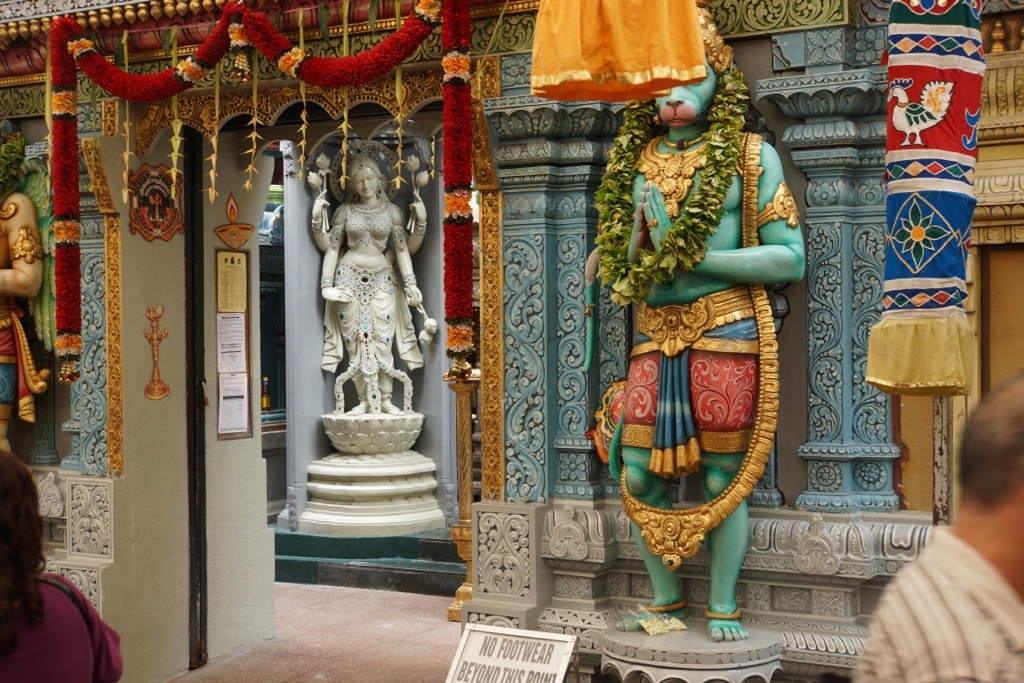
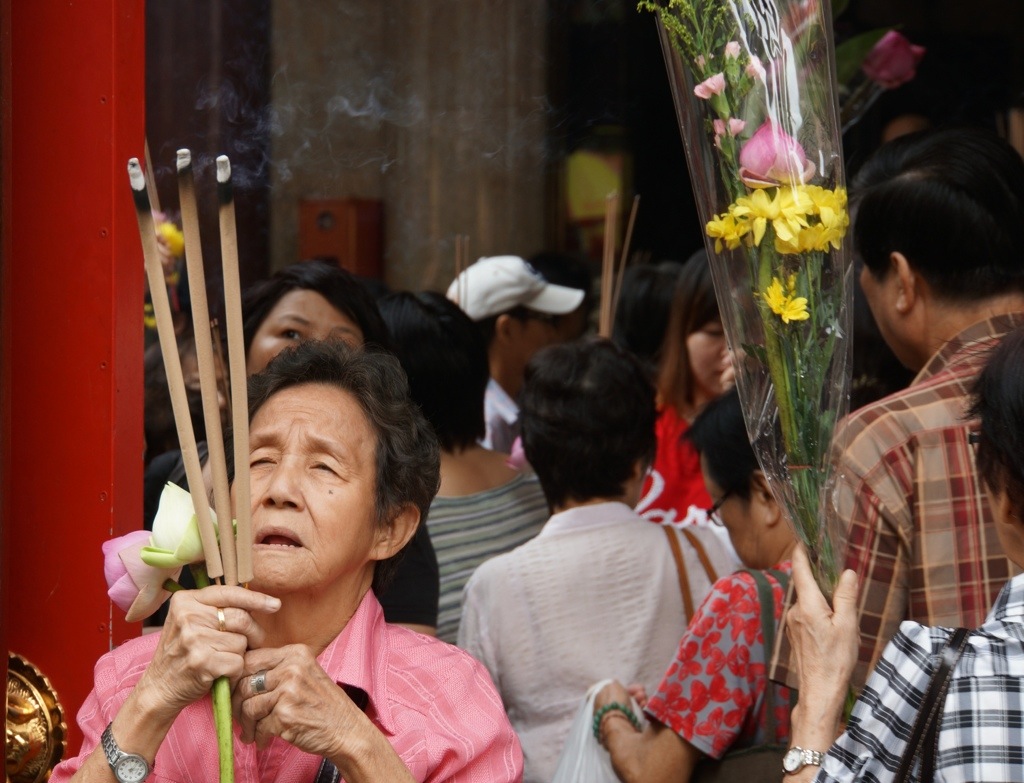
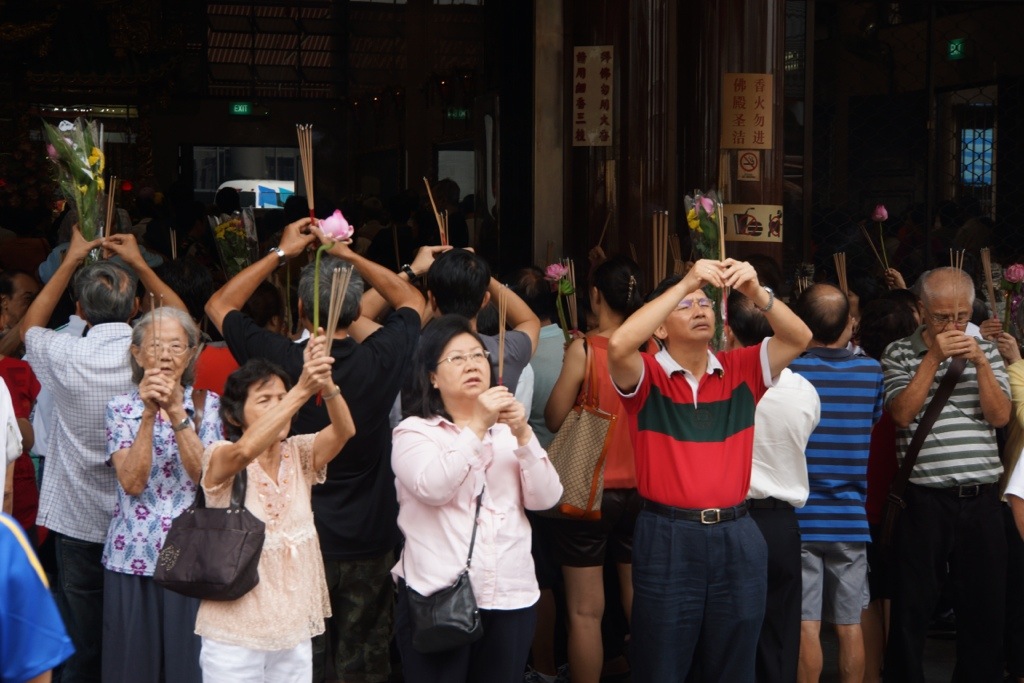
From there I took a taxi to the Peranakan museum, which Esther Tan had told me about. This was a really fascinating museum about the history, customs and lives of people of mixed breeds, formed when traders passed through the straits and married Malaysians. Very well done and interesting.
Taxied back to the hotel where I had very over-priced and mediocre mini-burgers in the famed Long Bar of the hotel. Well, one does need to see the Long Bar. Went up to my room, finished packing and stored the luggage for later.
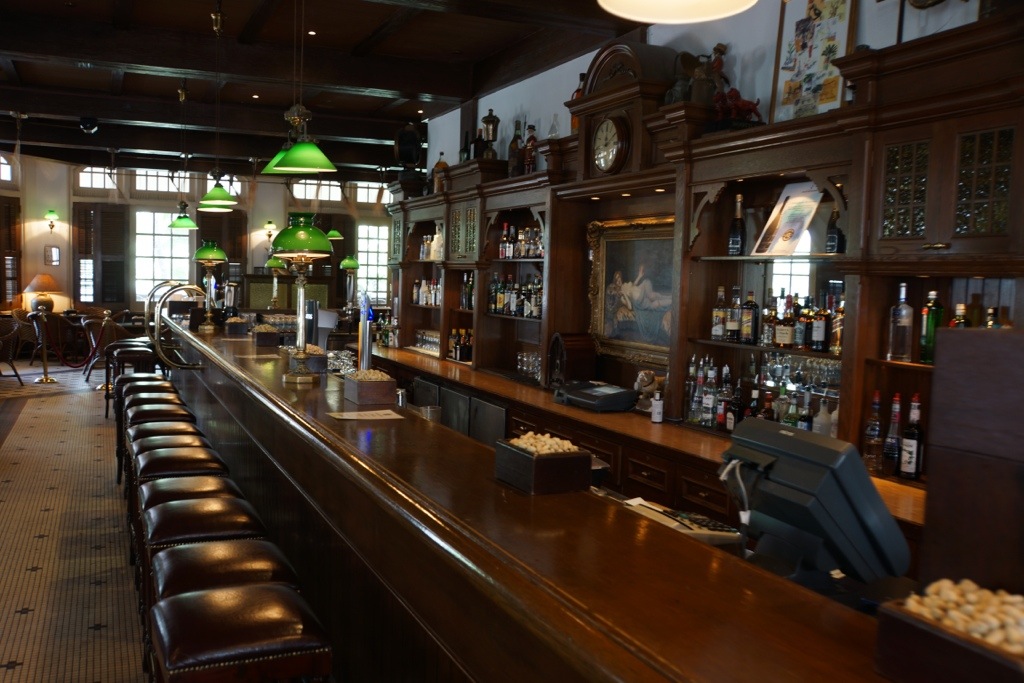
Had arranged to meet Rinpoche at the place he teaches in Singapore at 2:30, and he’d given me directions and location, but not an exact address. I was to contact him through the new WhatsApp he’d introduced me to, and he’d come downstairs to get me. Only trouble with that plan was that I didn’t have the wifi connection I needed for the App to work. So, when I got o the area, I wandered into a fairly seedy hotel and convinced the guy at the desk to phone Rinpoche. No answer, so I left a message as to where I was. Tried again 15 minutes later and reached him, so he sent the other rinpoche I’d met yesterday, Chung, down to meet me and bring me up to the modest sitting area, kitchen, bedroom and class room that constitute Rinpoche’s Singapore headquarters.
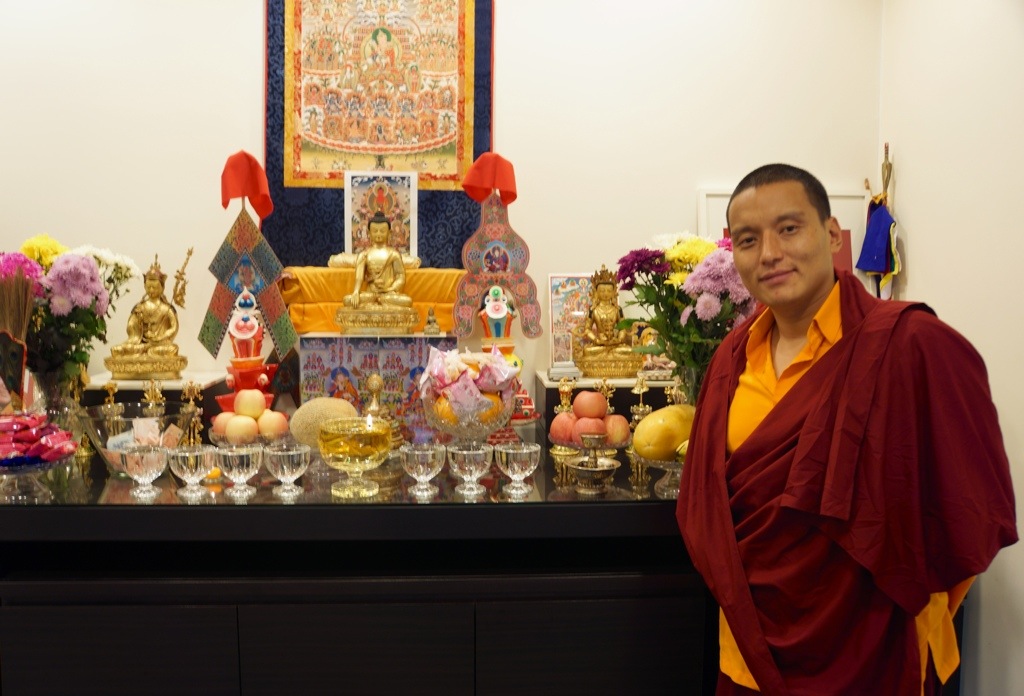
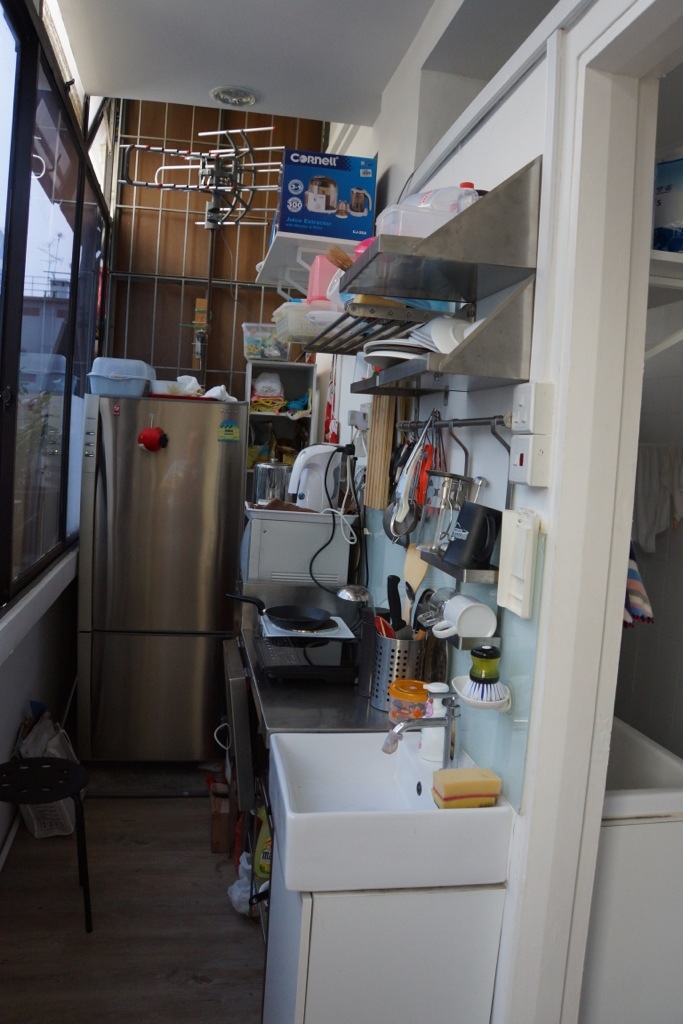
As Rinpoche was busy, I spent twenty minutes talking to Chung, who, at 29, is three years Rinpoche’s junior, and clearly looks up to him as a mentor. They studied at the same school in the South of India under the same master, who died shortly before I met Rinpoche for the first time. They now study under the same Chinese master, about 79, whose recent visit to Singapore is what drew Rinpoche and Chung to come there now. Both Rinpoche and Chung have traveled to China to study with this master, but not dressed as monks. As the Chinese do not take kindly to monks coming to study there, traveling there to do that was dangerous.
Chung was very friendly, but the level of his English makes him more difficult to understand. He is the third of seven brothers, four of whom are reincarnates. Three of the brothers live in Nepal, where Chung also spent several years. As a young boy of seven, he left his family to become a monk and rarely saw/sees them. He would like to come to the States, but that is very difficult to arrange.
Rinpoche rejoined us and told me that the hotel I’d stopped into to call him was a “love hotel.”. Having watched the clientele register, this does not at all surprise me. Rinpoche showed me around the headquarters. The altar in the classroom contains statues, flowers, fruit, other offerings, candles and photos of his former and present masters. He introduces me to two women students (disciples), who are very friendly. They drive us quite a distance to the famed botanical gardens, as Rinpoche and I planned to walk around them, particularly the orchid garden. The other woman says to call her when we are finished and she will pick us up and drive us back.
It’s pouring, so Rinpoche, Chung and I have coffee, then wander around the gift shop. The rain lets up some, Rinpoche borrows a couple umbrellas and we walk around for forty minutes in the light rain. I qualify for a senior admission, but Rinpoche is denied thatvrate, despite his wry plea that he is 450 years old. Rinpoche shows me how to use the panorama feature of my camera, which is quite neat, and I take several panorama photos. Rinpoche is interested in cameras, too, and has a Canon (but not with him; he takes photos with his iPhone). He likes to photograph flowers, the moon, various natural settings. I tell him that I’m far more interested in photographing people. He says that, as a rinpoche, he can’t photograph people, because that would not be in keeping with others’ expectations of proper behavior for one in his position.

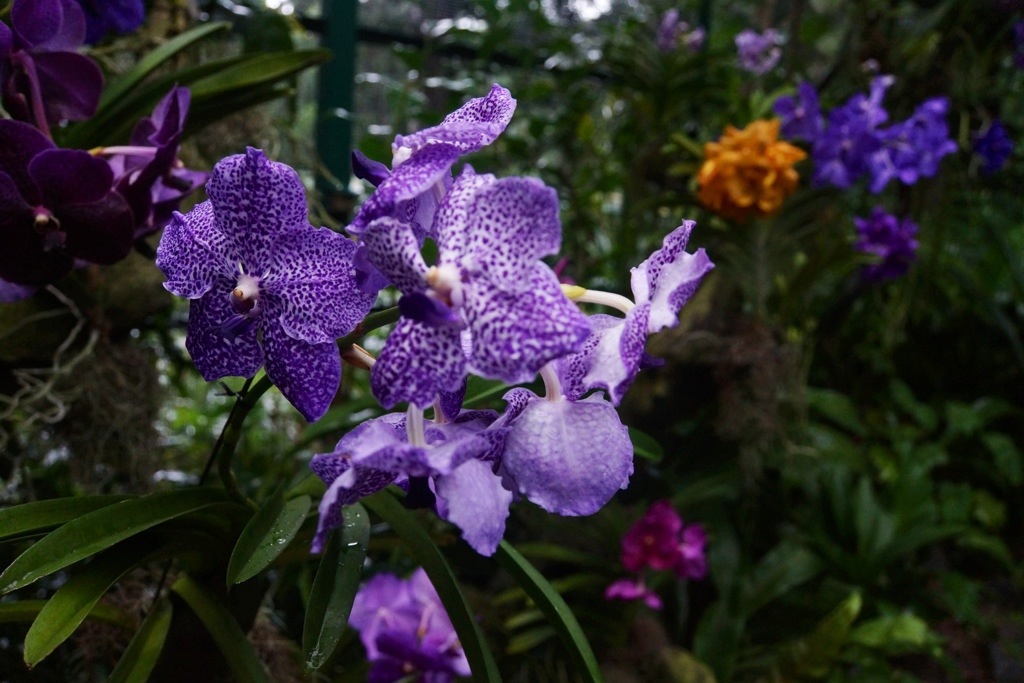
We are picked up and driven back. Rinpoche has a dinner that he tries to shift to tomorrow, but can’t, so we agree to meet back at the hotel later and walk around the Arab area. I’m dropped off at the architecturally interesting Arts and Science Museum, which has a major photography exhibit that Esther had told me about. The museum adjoins a huge, modern shopping mall, which I have to walk through. I like some of the photography, but not others, though it’s certainly worth seeing.
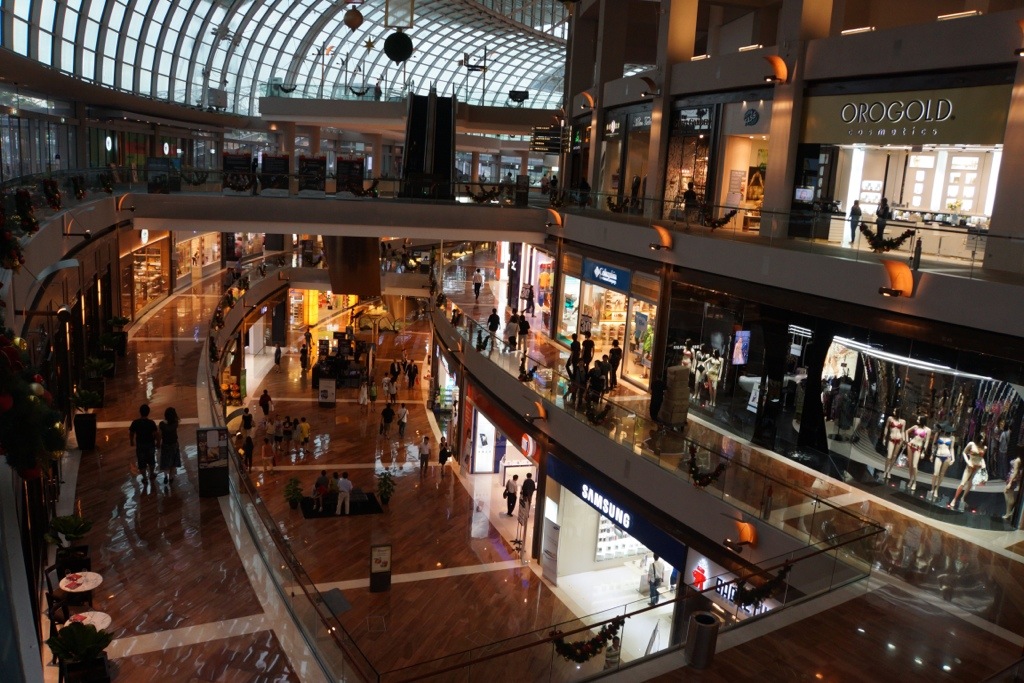
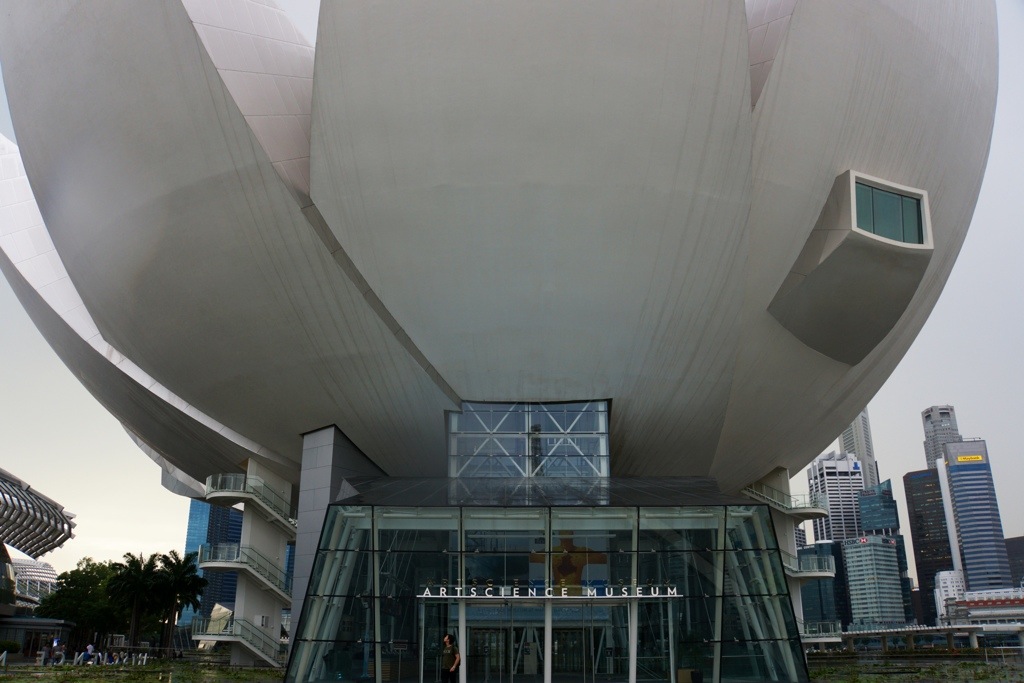
I walk back through the shopping center, stand in a long, but fast-moving taxi line and return to the hotel, where Rinpoche had suggested that I could use the spa. Though I’ve checked out, there’s no problem in doing this, and I use the steam room, shower and feel refreshed. I head down to a small lounge off the lobby for a club sandwich and a beer. A very good piano player is performing.
I use my new App to contact Rinpoche to tell him that I’d love to see him again, but that the thought of going out in the humidity and getting sweaty again before flying out is more than I can handle. He agrees to come over to the hotel and we pend another hour and a half talking, mainly my asking him about his reaction to the dialysis and kidney transplant he had. The experience has had a profound affect on him, and he is committed to two new projects because of it: getting more dialysis machines for Bhutan (there are only six in the country) and providing help to sick people whose needs (physical and emotional) he thinks are being ignored in too many cases. He is committed to building a shelter at the main hospital in Thimpu to house caretakers for these patients.
We talk about other things, as well. He will be going to Indonesia soon, because there are people there who are interested in building a monastery and school in Indonesia, modeled after his in Bhutan that they want him to run. He seems interested in doing this so long as he can be assured that the operations of the monastery will not be controlled by the funders. He also needs to get back to Bhutan in a few days because an architect from the World Heritage Fund who is interested in helping with his monastery is coming to visit.
He walks me to the front door of the hotel, where my car soon arrives to drive me to the airport. It was terrific to be able to spend so much time with Rinpoche, and to catch up. Staying in touch now, with the new WhatsApp, ought to be easier. Everything goes very smoothly at the airport. I spend a couple hours in the “important peoples’ lounge,” and I’m now winging my way towards Tokyo. Though it’s a long haul home, 6 1/2 hours to Tokyo and over 11 to Chicago (not including transportation to and from airport or airport time), everything goes smoothly. Business class helps the comfort level, and for the first time, I took an Ambien, which allowed me to sleep for 6’hours en route to Chicago.
The time spent before Guizhou, with Evan Osnos in Beijing, and after, with Esther Tan and Rinpoche in Singapore, made really interesting bookends to the trip. And staying at the Mandarin and especially at Raffles were a great start and finish. Only wish Carol could have been along.
If you’re game for another adventure, Carol and I will meet you in Myanmar (Burma) in January. I’ve appreciated the many kind comments and emails I’ve received in response to the China blog. It’s been fun to have you along. As much as I enjoy traveling, it’s very comforting to be in touch with friends and family along the way. I think this China trip would have seemed particularly lonesome without this ability to communicate, because of the fact that Carol was not along, because of the remoteness of the area to which I was traveling and because of being away for the presidential election.
November 13
Off plane about 10:20. No line at immigration. Bags were among the first off. Met by my air conditioned car, with wifi. As we get close to Raffles( my grand, 125-year old hotel), driver calls the hotel to say we’ll be arriving soon. I’m met at the door by a young lady, who calls me by name and shows me up to my large suite and registers me up there, takes my credit card and passport for a few minutes, then returns with it. As I didn’t eat the stuff on the plane, I dine on the fresh fruit in my room. And all this for only about a gazillion dollars a night. (But it includes breakfast, soft drinks from the minibar, pressing of three items a day (non-cumulative) and free local calls. So, how can you beat that? To paraphrase a line from The Wizard of Oz, “We’re not in Guizhou anymore, Dorothy.”
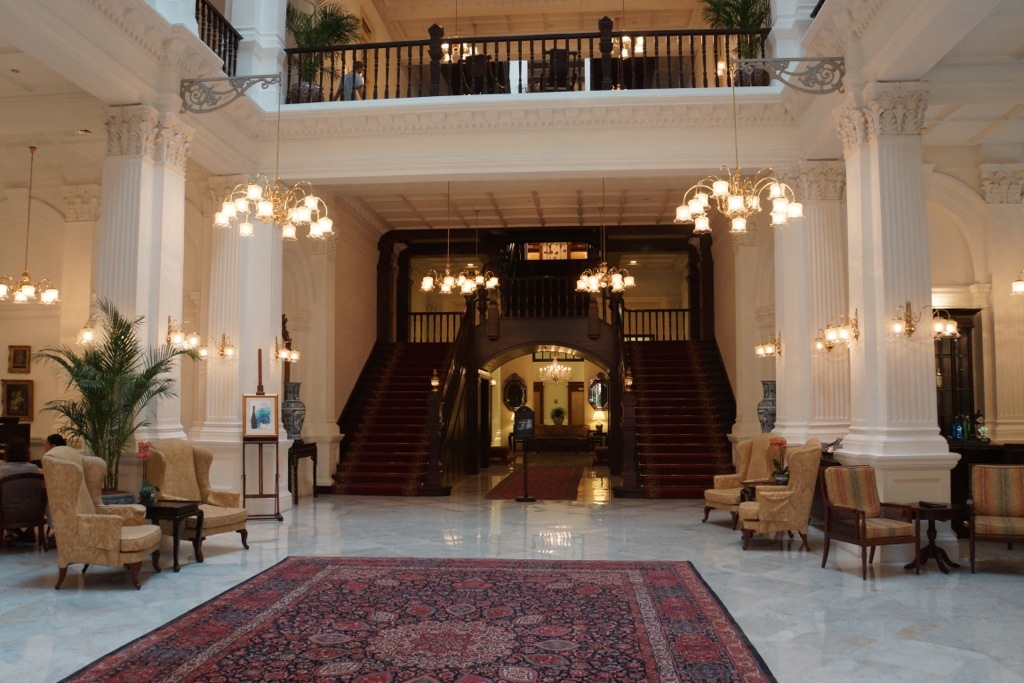
Excellent breakfast at the hotel, before I’m picked up by Esther Tan, who I’d been put in touch with through Jack Doppelt, a professor at Northwestern’s Medill School of Journalism, where Rachel Tan, Esther’s daughter, is a graduate student (well, that’s how things happen, right?). Esther very graciously spends several hours driving me around, showing me Singapore and telling me something about its history. We spend most of the time in the car to avoid the humid 85-degree temperature, which is relatively cool for Singapore.
A modern, clean, apparently prosperous city of some five million people. Government support of housing is a big reason that people are relatively well off. Maintaining that prosperity as a small country without resources (it depends on Malaysia, from which it split off in 1965, for water) and dealing with immigration concerns are Singapore’s current challenges. Still a British influence, evident from their driving on the “wrong” side of the road.
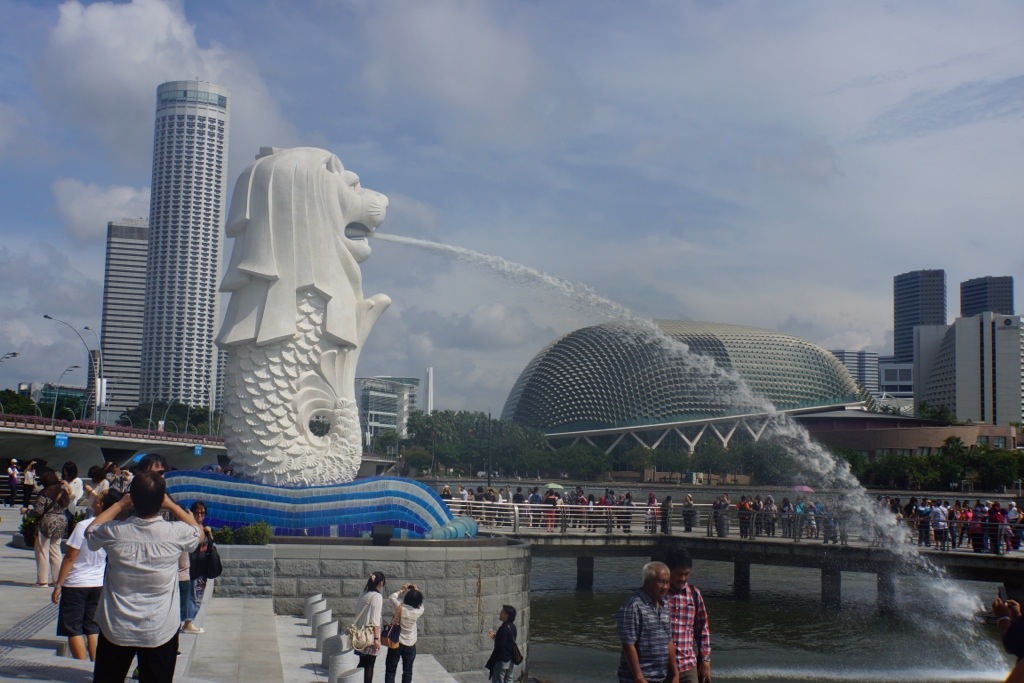
Went to a large shopping center, where we met Esther’s mother-in-law, Kay, and two friends, Get and Eunice, all of whom were entrepreneurs (retired, except for Eunice) and all of whom were lively and fun. They ordered about a dozen or more dishes, all of them different from the Chinese fare I’d had the past two weeks. Eunice does promotional work for clients so, of course, I talked to her about the books Carol and I have done. Will send her the latest, and be in touch.

Stopped to buy a couple short sleeve shirts for my two days here. Then Esther and I drove, stopped for coffee and I was dropped back at the hotel for my late afternoon meeting.
We need a bit of background to set up that meeting. When Carol and I went to Bhutan about three and a half years ago, we met H.E. 9th Neyphug Trulku Rinpoche, a Buddhist monk who is the 9th reincarnation of one of the twenty five disciples of the guru who brought Buddhism to Bhutan in the 8th century. We hit it off with Rinpoche, seeing him twice while we were there. When we first met, I told him that I knew that Buddhists taught that life is suffering, and I wondered what advice he had for Cubs fans, who had not won a World Series in over 100 years. He thought and said, “You should not be too sad, think of the joy you have brought to other teams.”. I converted him to a Cubs fan, so that he would know real suffering.
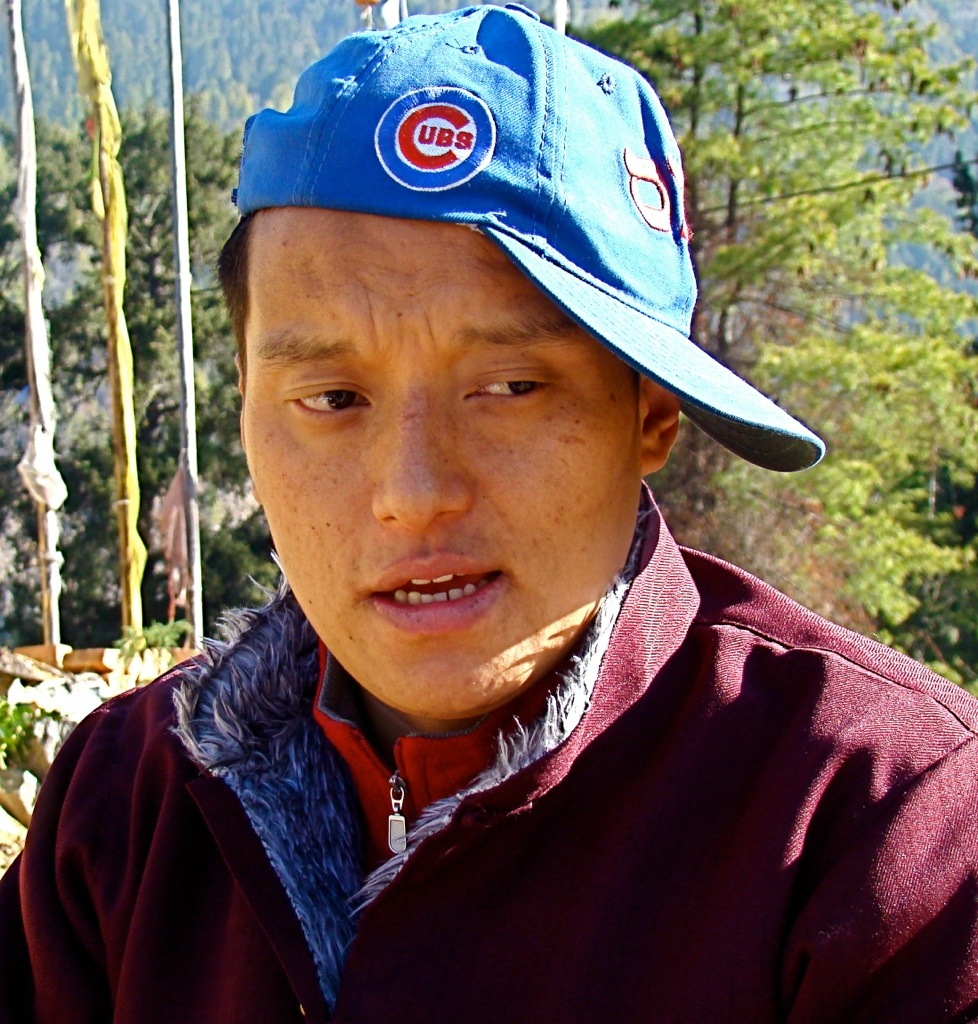
When I returned home, I got an email from Rinpoche (remember, he lives in a monastery up on a mountaintop and runs a school for disadvantaged boys) asking that I friend him on Facebook, thus becoming my only openly reincarnated friend. We maintained contact and a year and a half later I accepted his invitation to come to the annual festival at his monastery in Bhutan. He became seriously ill and, at 33 years of age, required a kidney transplant. This appears to have gone well, but needs to be watched carefully.
When I decided to go to China, I added a stop in Singapore, because there appeared to be a fairly good chance that Rinpoche old be there. Two months ago, though, I heard from Yvonne Eu, who works closely with Rinpoche in Singapore, where he does a lot of teaching, that he would not be there. A week before I left, though, Yvonne contacted me with the news that Rinpoche might be in Singapore after all. A couple days ago, we arranged to meet late this afternoon, including Yvonne, with whom I have had very extensive contact, but never met.
Two-hour tea at Raffles with Rinpoche and another rinpoche friend of his, Chung Trulku, from Bum Thang in Bhutan, joined for the last 3/4 hour by Yvonne. Rinpoche looks and seems quite terrific, a year after a kidney transplant. There were some scary moments before and during the process, but he appears to have pulled through very well.
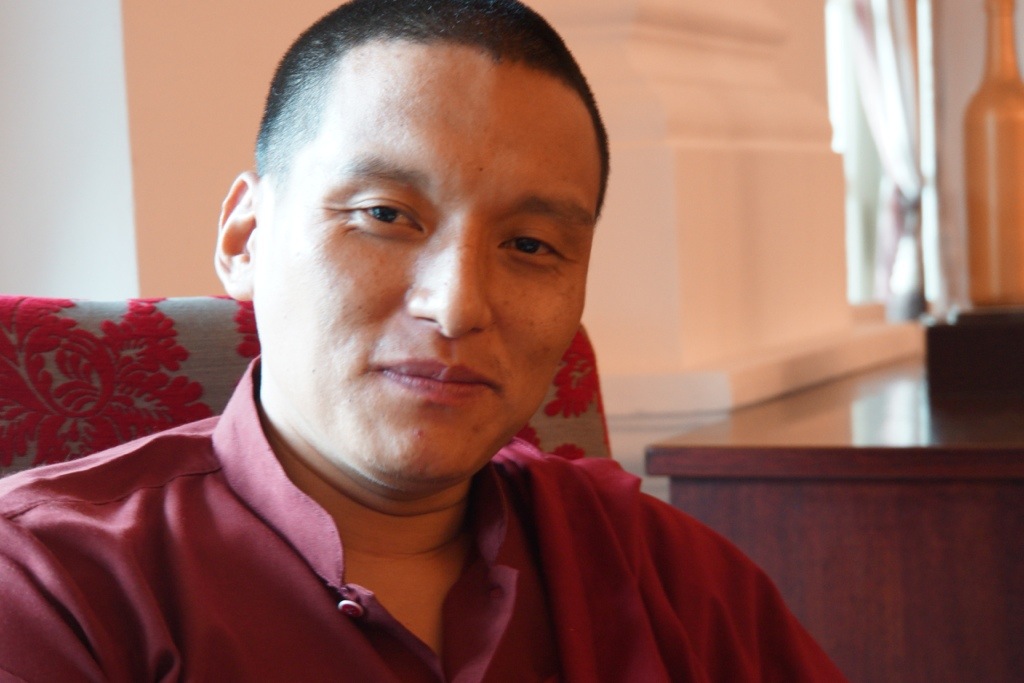
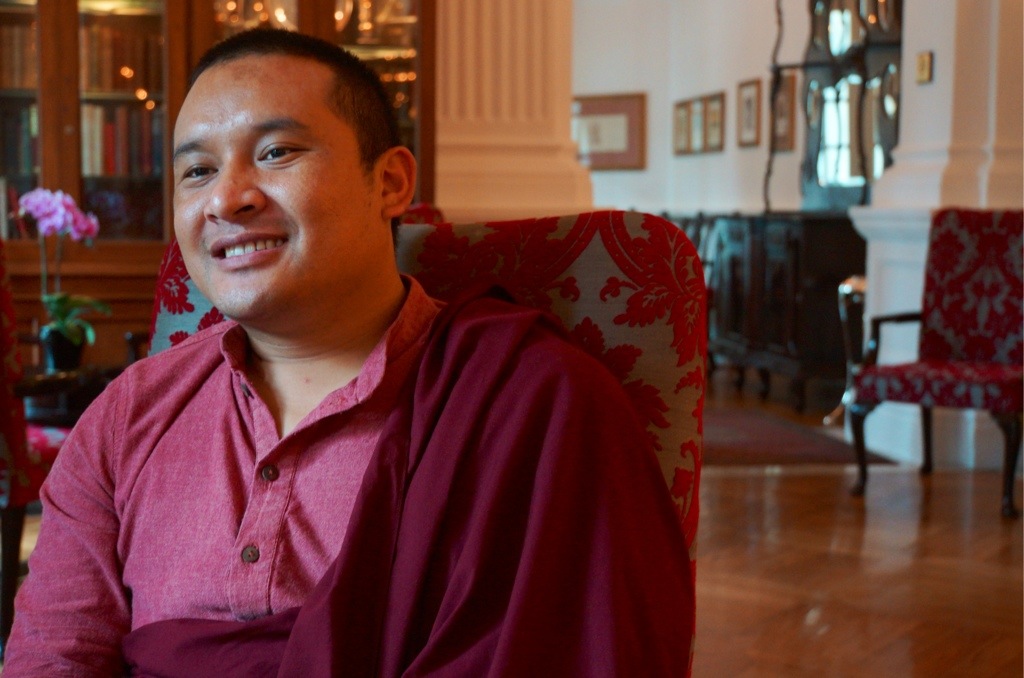
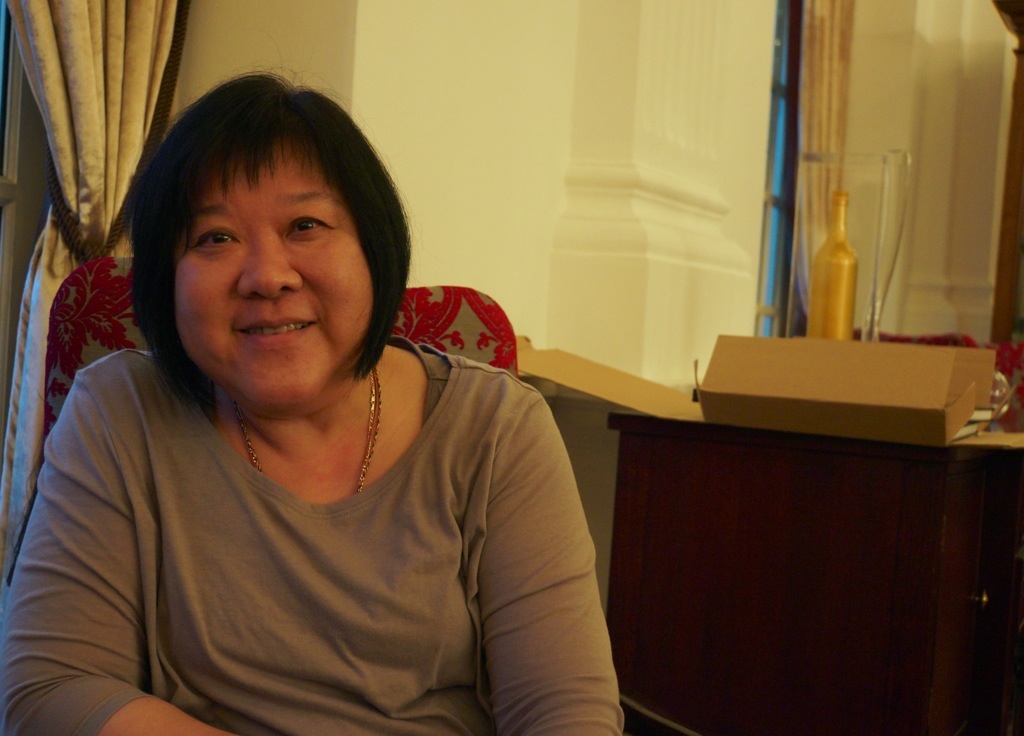
We talked about what is going on at the monastery. Some plans he’d had for renovation had fallen through, but he thinks others he’s working on may well occur.
We talked some about his illness. Over 80 people had volunteered to donate a kidney for him. One of his young assistants at the monastery, Sanjay, was the eventual donor.
He installed a new app on my iPhone, “What’s App,” which he said would allow us to stay in closer touch. Then he taught me how to use it. One of the things I love about Rinpoche is how seamlessly he moves between centuries.
He asked me how the Cubs had done, and I told him that he was a dismal failure. He said that it’s possible he may go to New York and, if he does, he’ll come to Chicago to visit. I told him that I thought a personal trip to Wrigley Field was necessary to get the Cubs on track.
We needed to break up around seven,but he’s coming back to the hotel for breakfast tomorrow.
Esther picked me up for dinner at Jumbo Seafood at Dempsey, a very happening part of Singapore, built on a former army base. (Singaporean men are required to serve two years in the army after high school and a month a year after that, which employers must allow in addition to vacation.). Dinner was terrific and unusual, including chili crab, scallops in a ring of yam and mocha pork ribs. Esther dropped me back at the hotel, where I blogged and tried to get a bit organized for my last day.
November 12
After an early breakfast, we set off for the Guiyang airport at 7:30, expecting to arrive by 10 AM. Evelyn had an early morning flight, so left to stay in Guiyang after dinner last night. All of the rest, except for Sheilah, are on the same flight to Beijing. Sheilah and I fly to Guangzhou, she then on to Hong Kong and me to Singapore. It’s going to be a very long travel day as I have a 4-hour layover, then a 4-hour flight to Singapore, arriving at 9:50 PM. So, I hope to use part of that time to reflect on the trip. Sorry, no photos today.
Arrive at the Guiyang airport in plenty of time, but find that my baggage is overweight. They do not take either credit cards or dollars, and the bank that a nice young woman leads me to will not change dollars. Fortunately our guides are at the airport and change money for me, so I am able to pay the (considerable) fine.
I’ve been the principle consumer of peanut butter on the trip, so I was presented the remaining jar, with some crackers. Going through security, the jar of peanut butter is confiscated, much to the amusement of the rest of the group.
Okay, so, the trip. There are really two separate, but related, aspects–travel around Guizhou and photography.
First, travel. Wonderful. A different experience than I’ve had, seeing tribes in this remote area of China through visiting their villages and festivals. The diversity and richness of our experiences was quite amazing.
Great credit goes to Nevada and her team of Xue Biao, Lee and our driver, Lao Weng. All of them were focused on the needs of each member of the group at all times and often went out of their way to satisfy them. Nevada is a real pro, not only as a photographer, but as a trip planner, as well.
Nevada did a terrific job of setting (lowering) expectations in us from the outset, stating clearly and repeatedly in her materials that this was not a trip for everyone. That is true. It was not an easy trip. By the end of the trip, the group was something of a walking infirmary, with most suffering some sort of cold, cough, sore throat, respiratory ailment or some combination thereof. Slogging continually through mud, often in chilly, damp and rainy conditions, hiking up, down and around, packing and/or unpacking most days, riding in a less than roomy bus, sometimes for long stretches over bumpy roads–all of this was not a walk in the park. But I think every of of us would say that the trip was well worth the tribulations.
We covered a lot of ground, traveling about 1500 kilometers. While that does not sound like a huge distance for two weeks, when you factor in the poor condition of many of the roads, it amounts to a lot of travel. Our maximum altitude was over 4200 feet, and we went up or down some 80,000 feet on the trip. (Nevada has a gadget that tracks those things, so I felt I had to report them.)
A word about the group. We had a very congenial, fun-loving group of ten people, all of whom were experienced travelers and, at one level or another, photographers. In any group of ten, one is bound to like some more than others, but there were none of the losers one often encounters in group travel. Once again, I think that Nevada deserves credit for helping the group gel, because of her infectious and upbeat manner.
Second, the photography. A number of you have written, wanting to know more about that aspect of the trip, so here goes more than at least some of you may wish for. Feel free to skip or skim; this won’t be on the final exam.
Over the years, I’ve been to many places and taken many thousands of photos. Along the way, I like to think that I’ve improved some. But this trip was transformational from a photographic standpoint. I began to glimpse how much I did not know and to sort out in my own mind what I might like to do going forward.
Quantitatively, I took more photos by a factor of three than on any trip I’d ever taken. Part of that was simply because photography was the heart and purpose of the trip. Part of it was because, unlike other trips, I never had to be concerned that I would be holding others up by taking photographs. And, finally, it was because I routinely took many photos of the same setting, because I left the camera in drive mode, so that when I held the button down, the shutter would continue to shoot in fractions of a second until I released it. This allows you to capture subtle changes in a subject and, for example, to avoid a photo with the subjects’ eyes closed.
For those of you who may be experienced photographers, much of what follows may evoke a, “Well, duh” response, but I suspect that many of you will be surprised that some truisms turn out not to be true. A few examples:
The ideal situation for taking a good photograph is a bright, sunny day.
2. When you go into a place with poor light, you use your flash to illuminate the subject.
3. A photograph that is not sharp is a poor photograph.
4. If you have somebody in your photo who is not part of the main subject, you’ve made a mistake.
5. The best way to photograph somebody is straight on, at eye level.
6. When you are taking a photo of one individual, the best picture is a vertical one.
My concept of what is a good photograph has changed dramatically. Most all of this is due to listening to and/or watching Nevada. I now understand that I am doing more than “taking” a photograph, I am “making” a photograph. Through the way I choose to take the photo, I can transform a scene that is not inherently interesting into a good photograph and, conversely, I can take a subject that could be great and transform it into something dull or uninteresting. In other words, it takes more than an interesting subject to make an interesting photo.
There are four, perhaps five, possible elements to a photo: color, light, action and composition (and the fifth would be gesture). For me, I think my strength is composition, and I think I get and can practice capturing gesture. Light is something I need to understand much better and work on, but at least I now “get” the importance of light. Action may or may not be present in a situation, though there are times when I can enhance the sense of action by choices I make. To the extent that color is related to light, I need to work on that, too.
Nevada says that she likes problems, because solving those problems leads to creativity. In any situation, she looks for the problems. That would be a good thing for me to do, too, but I’m certainly not there yet.
Here are some other things I learned.
Background is much more important than I’d thought. It can either enhance the photo, or distract.
I need to move around much more, both around a particular subject and, for example in the festivals we went to, all around the festival.
You need to try to relate to your subject. Smiling is good, as is speaking even a few words of the language. Showing the subject the photo you’ve taken may warm her up for a better follow-up photo.
You want to capture moments. That’s not easy to understand in the abstract, but when you look at a photo and Nevada says, “that was a nice moment,” you know what it means.
In some situations, it may be possible to layer a photo, by showing people doing different things in the same photo, perhaps cooking in the foreground and eating in the background. That is one way to tell a story, another aim of a photo.
Shooting at different angles, panning (moving the camera as you shoot), getting people to look directly at you and even to shift their position, framing subjects horizontally (I was doing too much vertical) and taking photos in low light are all creative choices available to you.
I have not talked about technical proficiency and equipment. These are areas in which I’m going to tread very lightly. I do need to understand more technically, but I just don’t have the interest in plunging deeply into that area. I recognize that this will limit what potentially I can do, but that’s okay.
I have a similar attitude towards equipment. A month before going on this trip, I bought a Sony NEX 7. (I was introduced to the camera by a professional photographer friend, Dave Jordano. If you want to see some amazing images at a level to which I do not remotely aspire, take a look at www.davejordanophotography.com.) The camera is a high quality digital SLR that is very light and versatile. I have an18-55mm lens and an 18-200mm. I watched my fellow group member lug multiple cameras and heavy lenses and I was very happy to have made the choice I did. At least for now, I intend to stick with that.
One thing I’ve mused on is whether the new sense I have of what I want to accomplish in a photo will be shared by friends, family and others who see my photos. Not having been through the experience I have, they may prefer the types of images I used to capture. I suppose time will tell, but I’d be interested in any of your thoughts on this.
Well, I’m in Guangzhou and about to head towards my gate for the flight to Singapore. I am looking forward greatly to time I’ll be spending there, but I’ll save that story for a post from Singapore. As we say in China, hasta luego.
November 11
Set off after breakfast (scrambled eggs again) for the old part of Kaili, a city that has grown dramatically over the past decade or so to a population of about 400,000. Judging from the enormous amount of new construction that we can see from our hotel window, it’s probably destined to at least double in size in the coming years.
Short bus ride to the old city of Kaili, where we walk through an enormous, bustling market that materializes every Sunday. Minority groups wearing traditional garb mix with western dress. Because of the large number of people and high level of activity, it’s not ideal for photographing, with the notable exception of a small lane, inhabited by old men selling tobacco and pipes, who are smoking. After a couple hours, we return to the hotel, then out to a nearby restaurant for lunch.


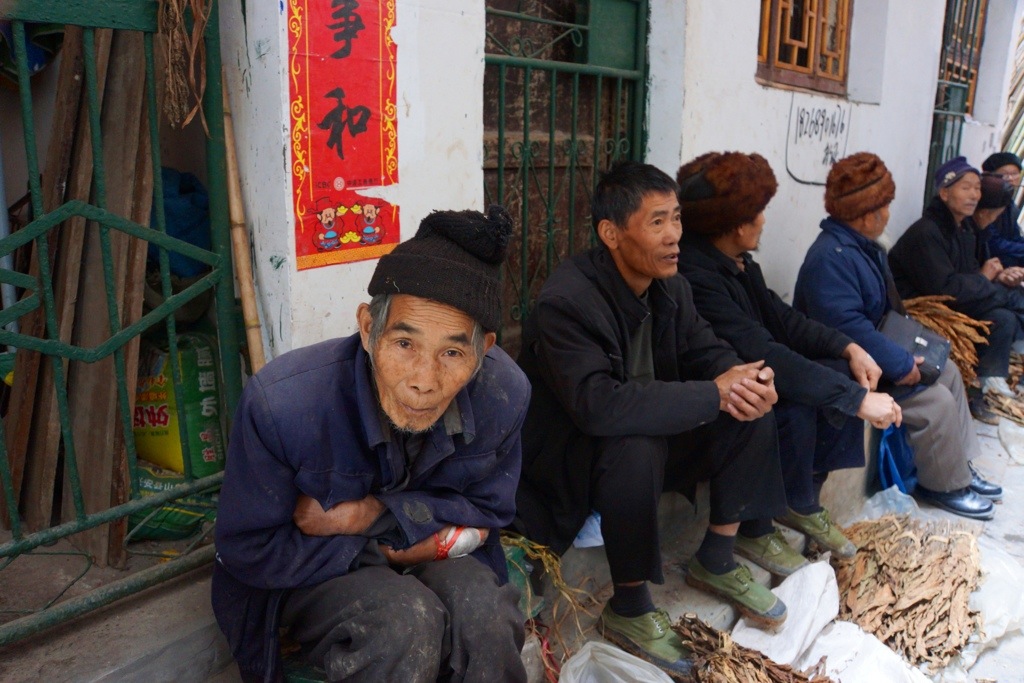
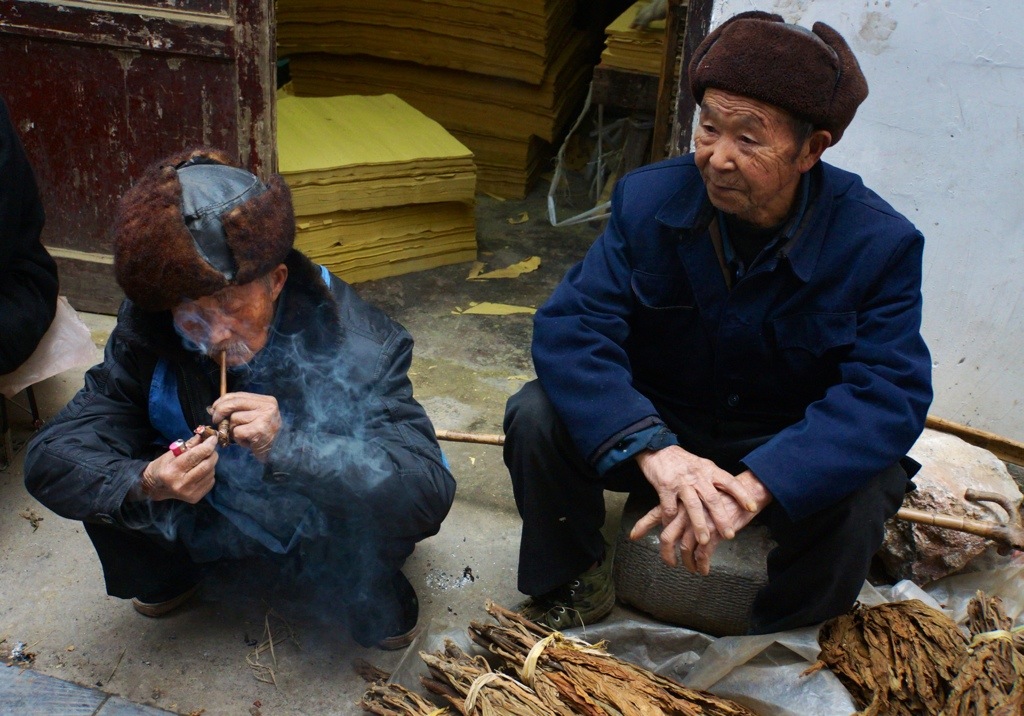
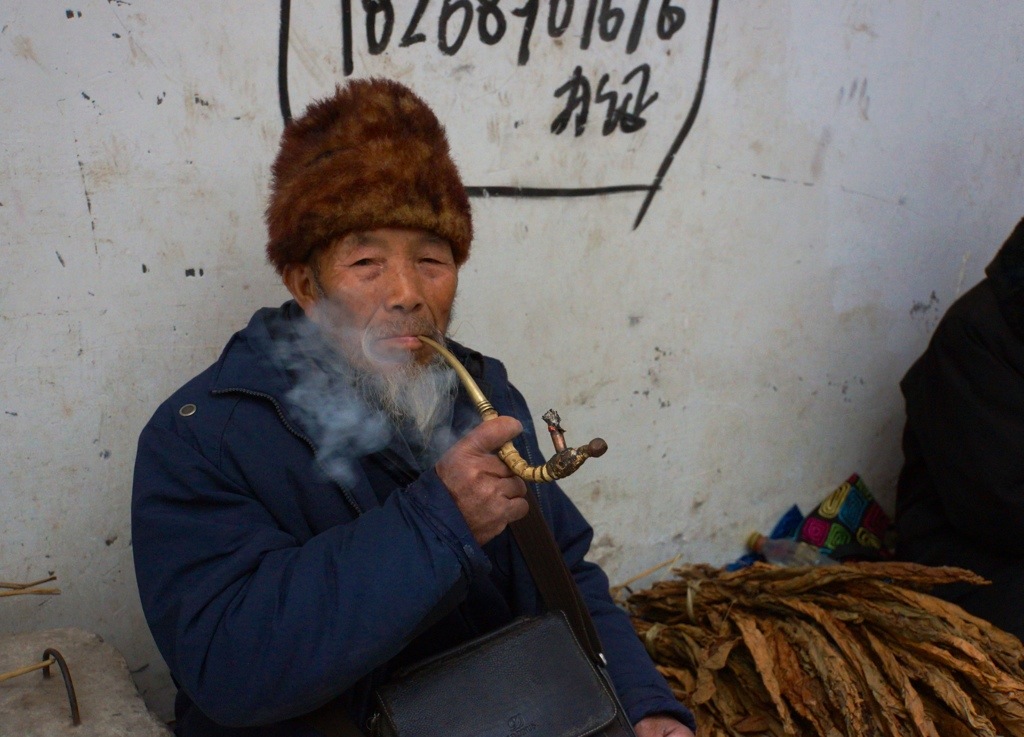
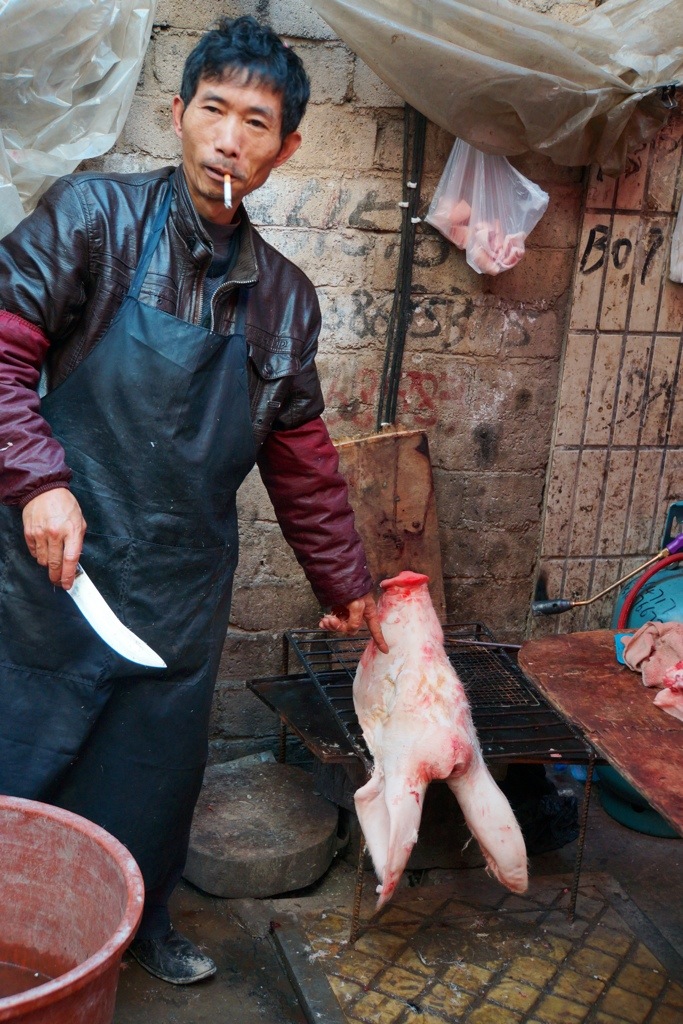
Three members of the group decide to go to a final village. Several others buy embroidered work from a guy who set up shop in the hotel lobby. I spend some time with Nevada, getting her comments on some of the photos I’ve downloaded, which is very helpful, both in confirming many of my impressions and getting a different perspective on some of them.
Pull some things together, blog and rest up before our farewell dinner, which is held at at another hotel and features Beijing Duck. I read “what really happened on our trip blog” and people seemed to enjoy it. Many toasts and comments about what a great trip we had.

November 10
Breakfast in the hotel includes some scrambled eggs, so I actually eat a real morning meal.
Stopped at Wengxiang village, where we saw a terrific master weaver named Madam Li Jing Ying and her mother, Deseng, who wove, sang and did a little dance for us. Went overboard on the photos, as I think everyone in the group did, because it was such a terrific, colorful setting. (I took 280 there, but walked back with a group member who had taken 550. Also took some video of the singing and dancing with my iPhone, which i should have been doing all along, but haven’t.) The quality of her work was comparable to what we saw in Madam Yang’s museum. Afterwards, the group bought a good deal of embroidery from her, easily making her month, if not her year. Suzette is the champion shopper in the group.
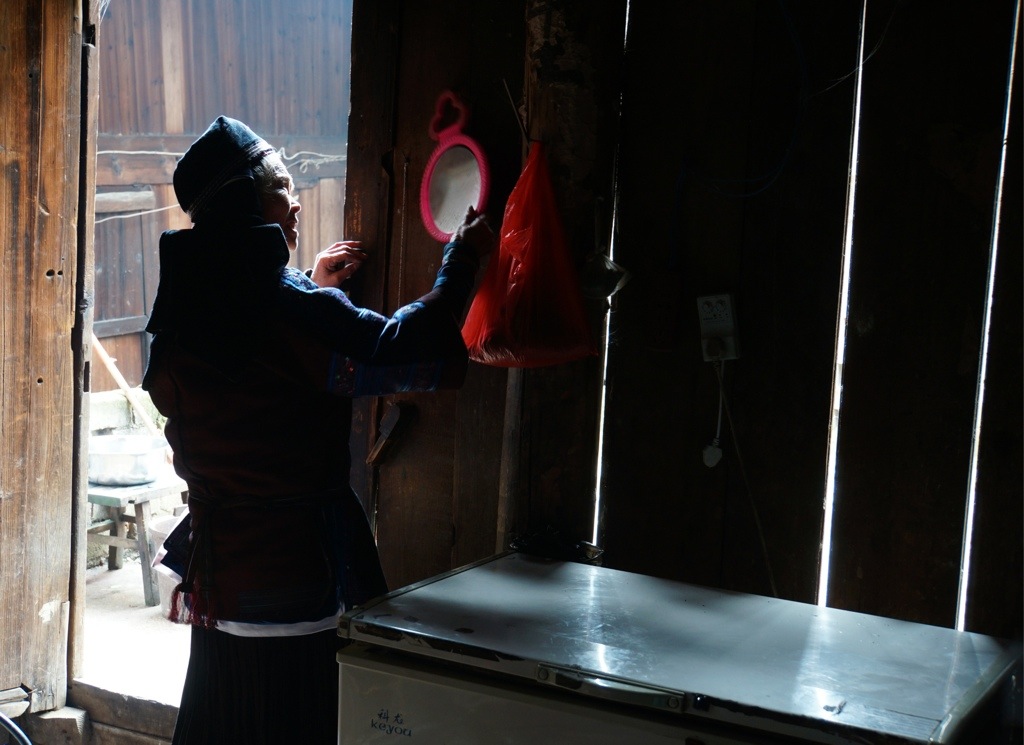
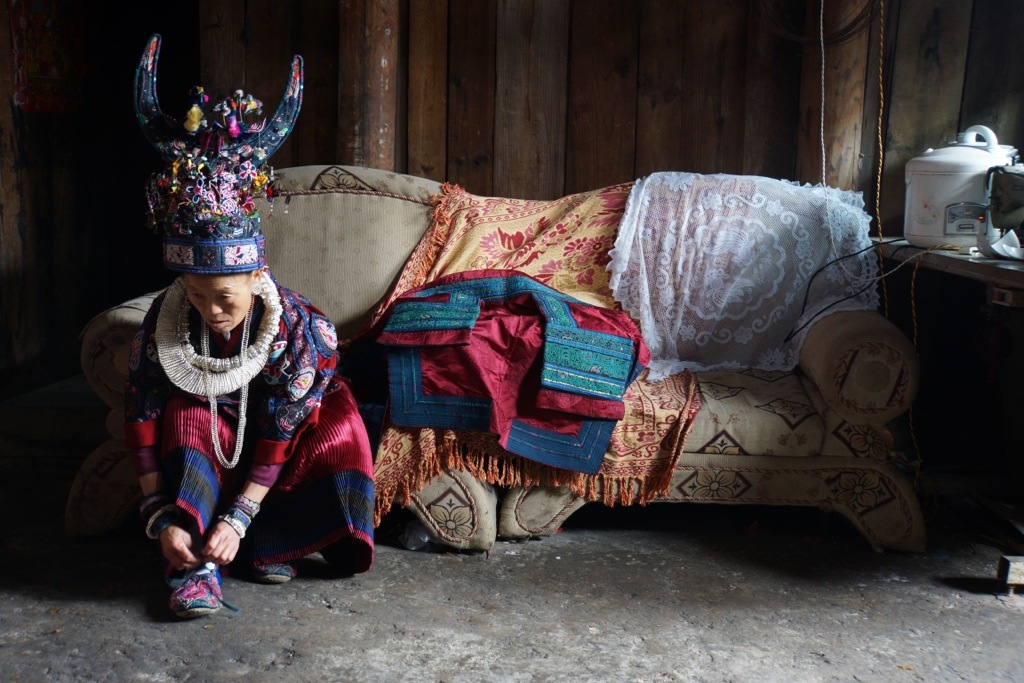
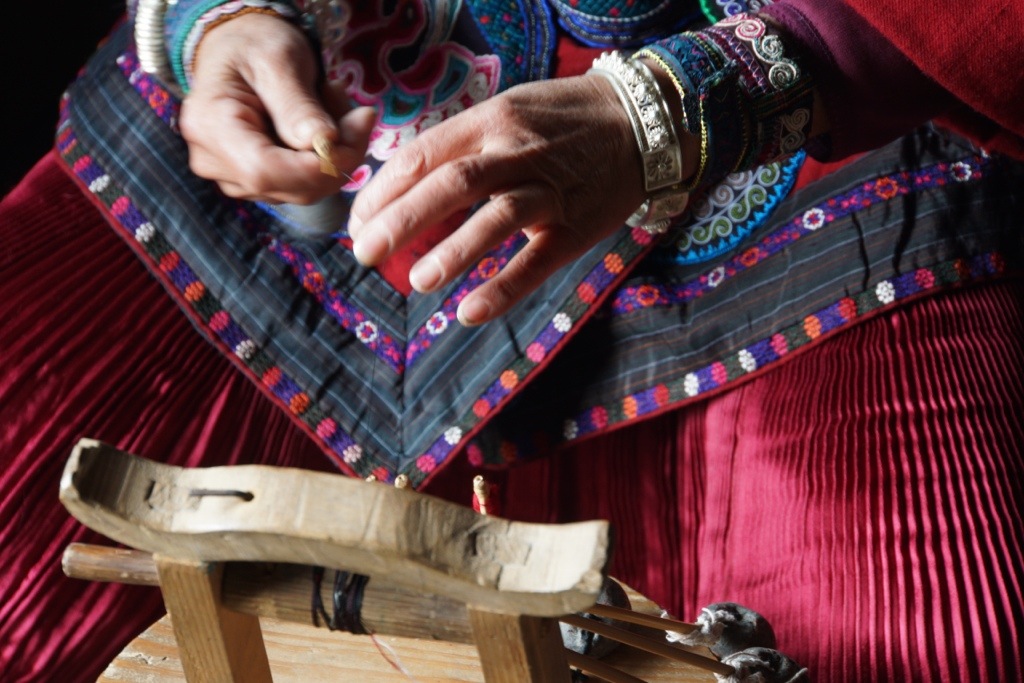
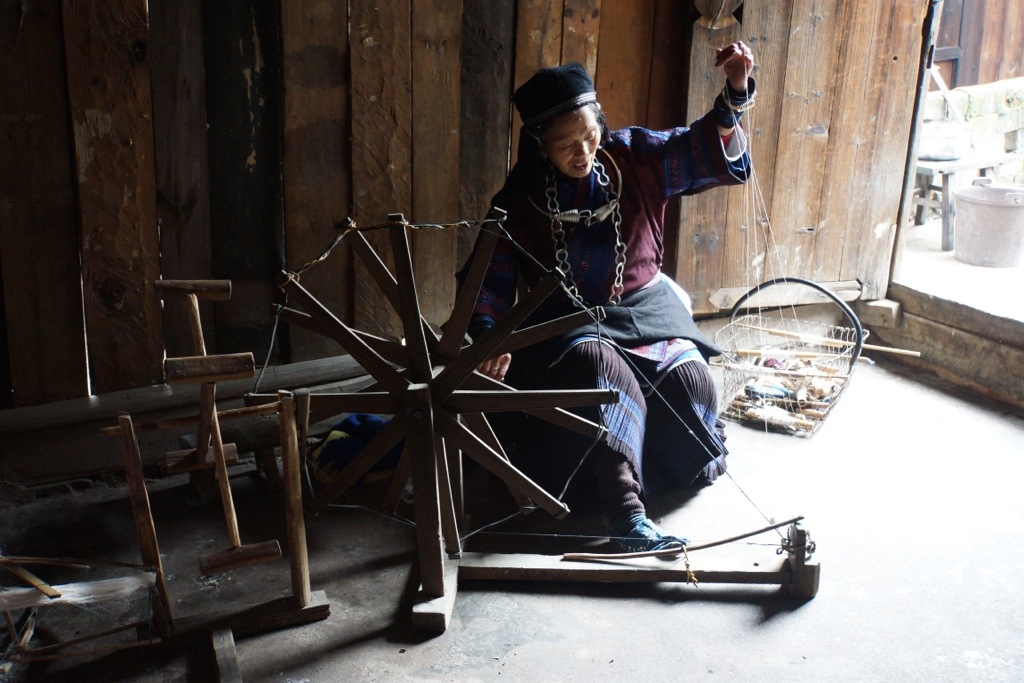
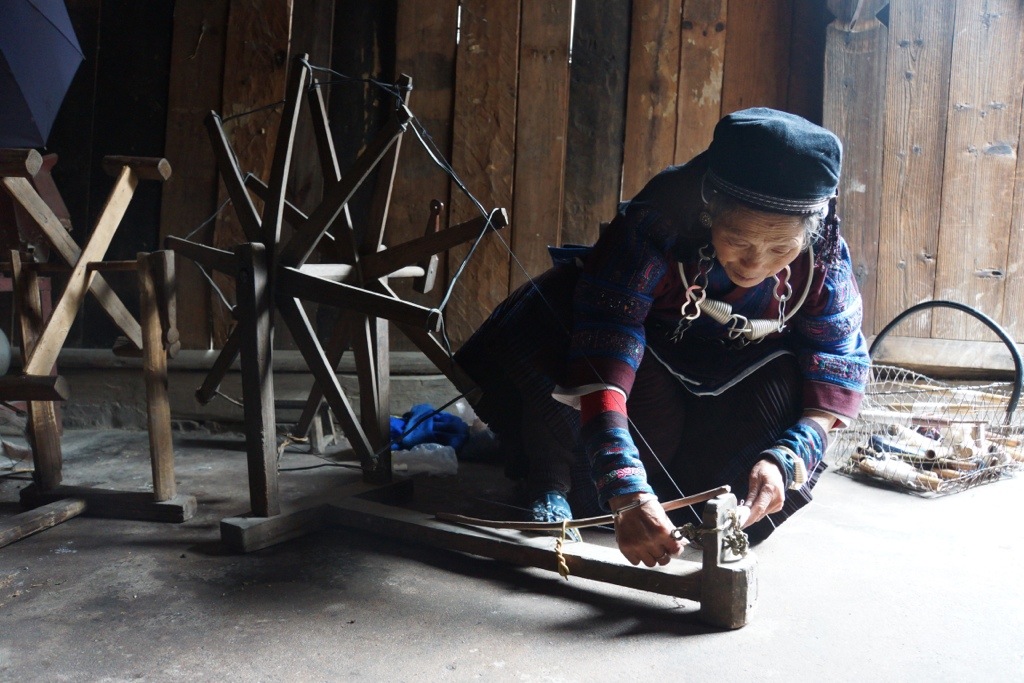
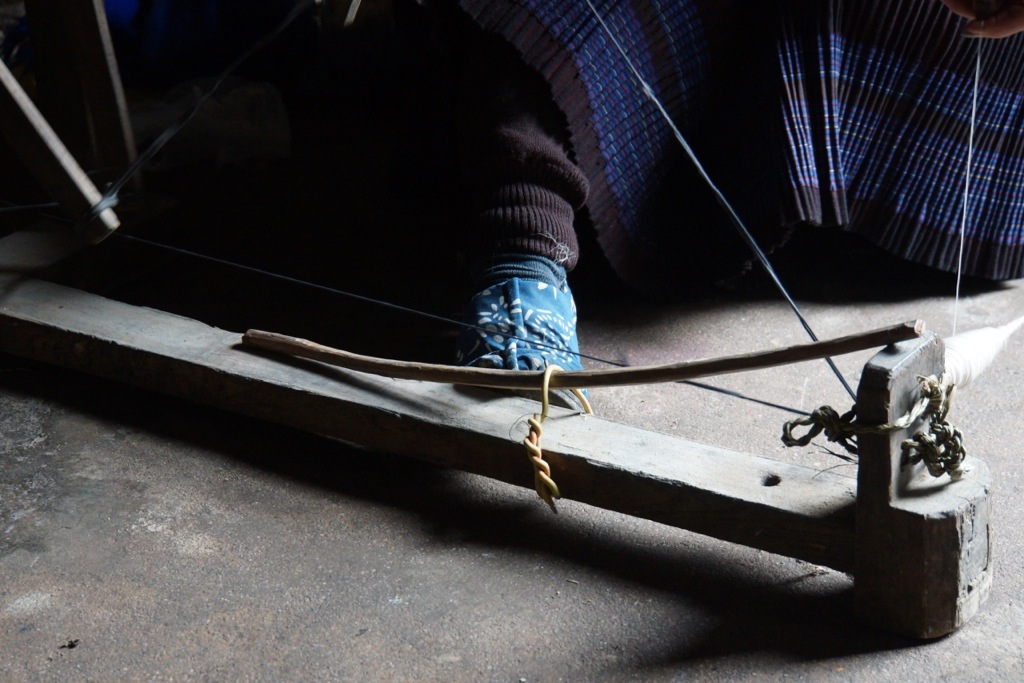
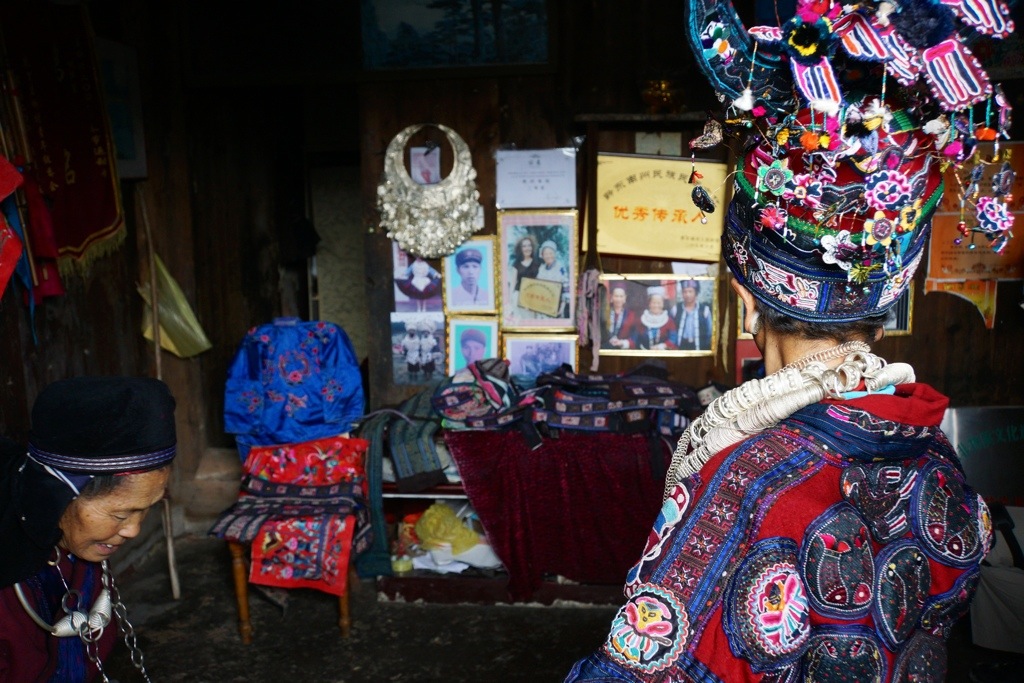
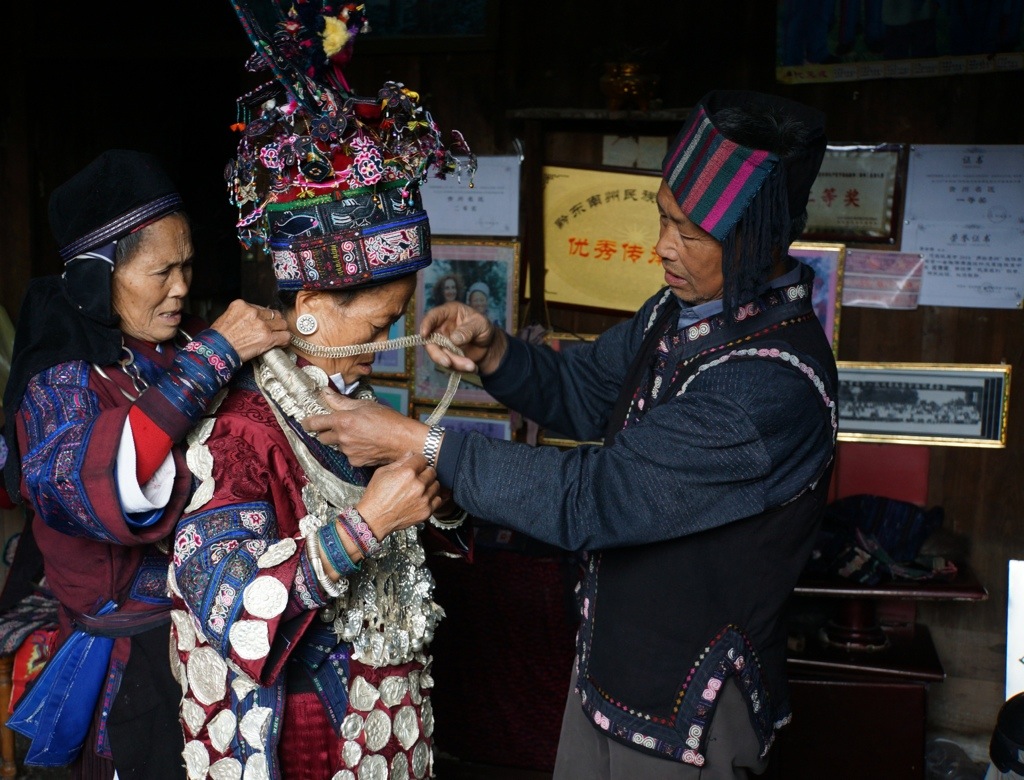
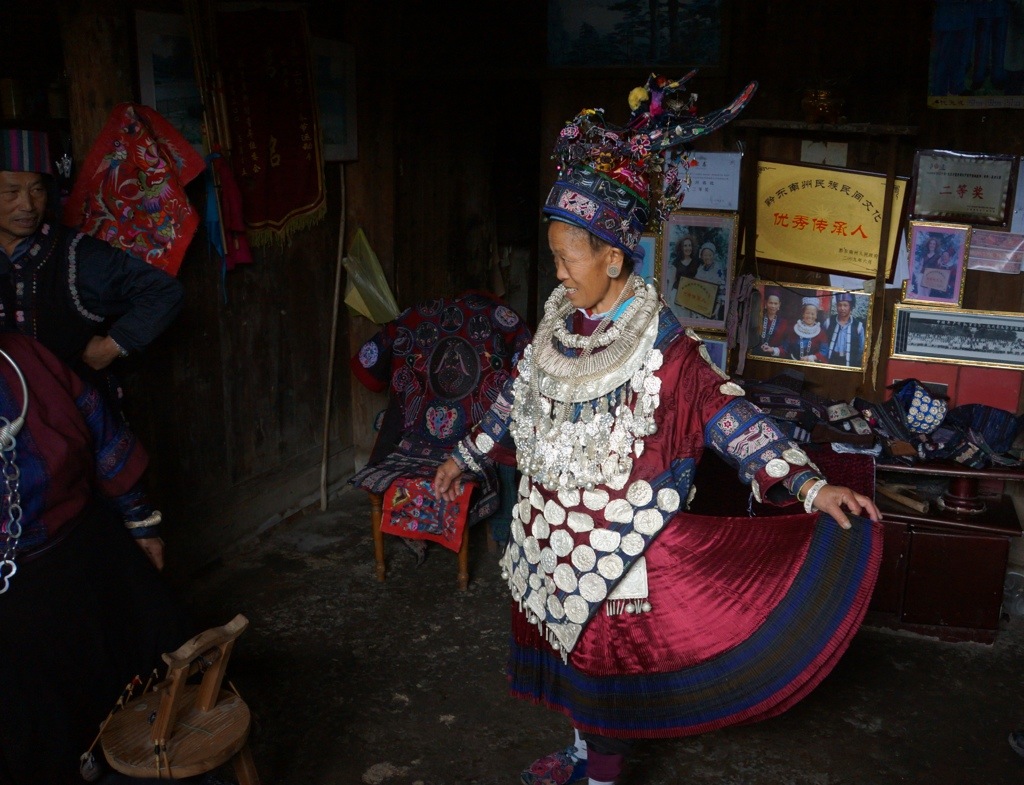
Lunch in Panghai, then drive about an hour to Gulong for our last festival. Huge traffic/parking jam on the way forces us to stop/park well short of the festival and hike down into something of a hectic mob scene. Initially waded through the muck to see bull fights at a great distance. Did not stay long, though, and made my way into another area.
Costumes of all sorts, traditional and modern, cotton candy made the old fashioned way, cute little kids, including small girls in full regalia dancing, popular singers performing on large stage to a very attentive audience, bulls being led down the street, hair dos of all sorts on women and men, some folks who had had a bit too much to drink, men carrying their song birds in covered cages. Different in scope and pace from the others festivals we’ve seen. Difficult to photograph, but once you accepted that, it’s a lot of fun just to soak in. So spread out and chaotic that I find out later that I missed an entire area where dances were done, which I regretted, but I was not the only one to miss it.

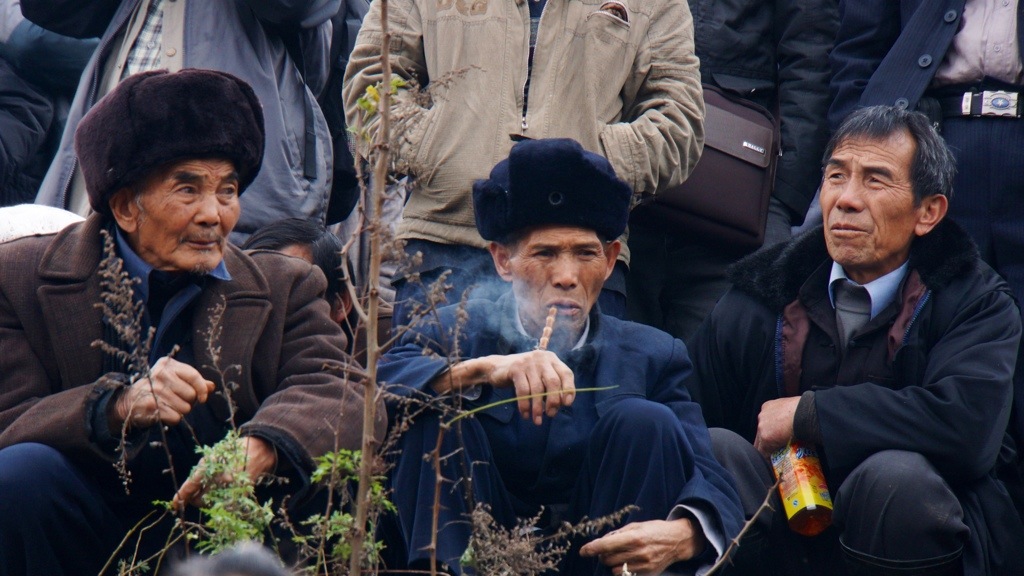
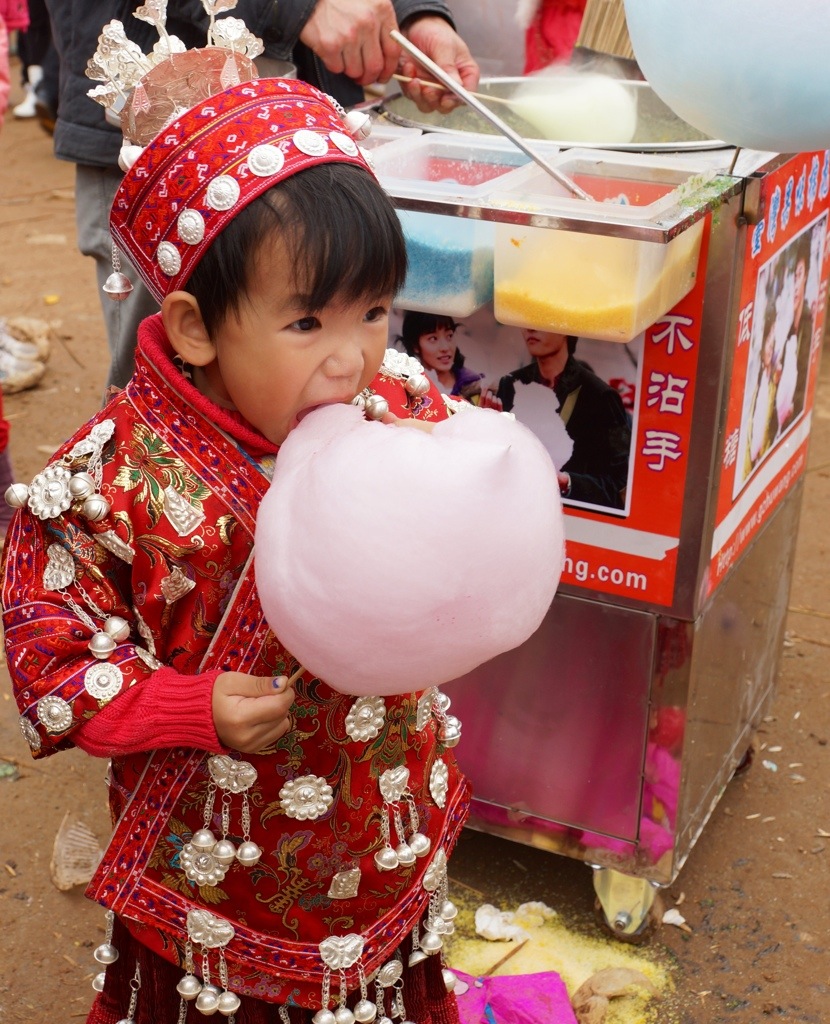
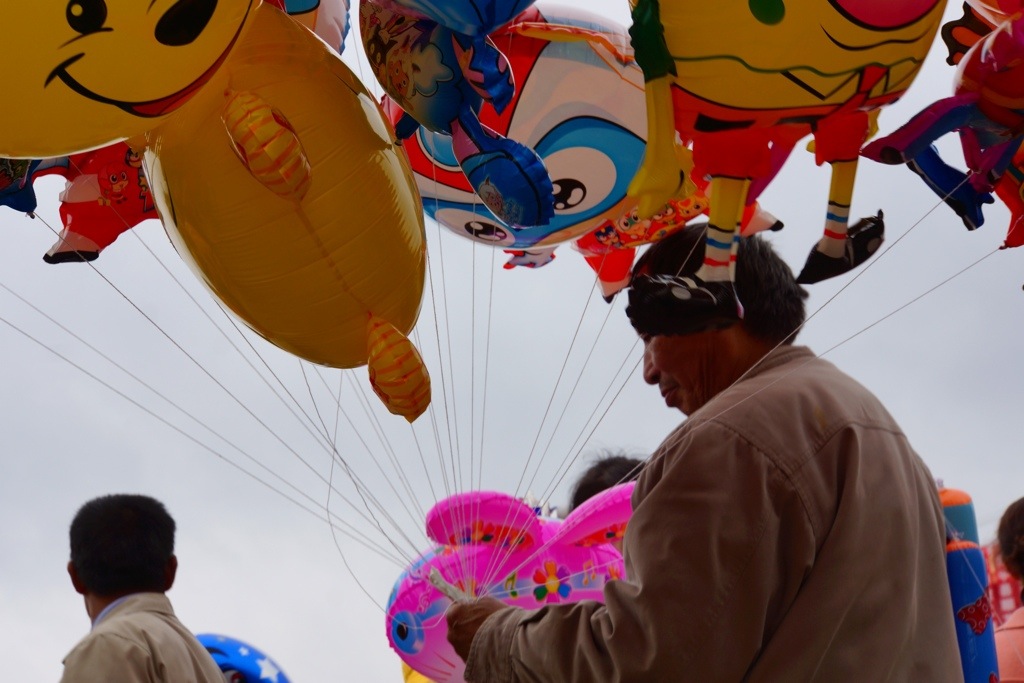
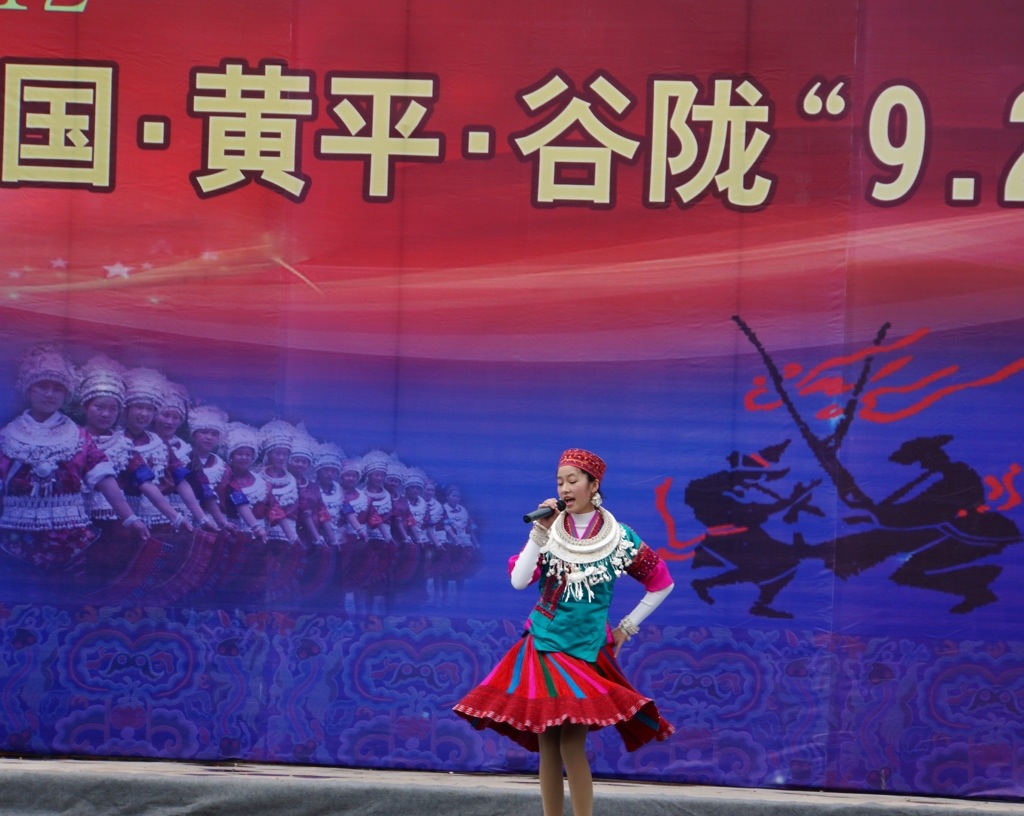
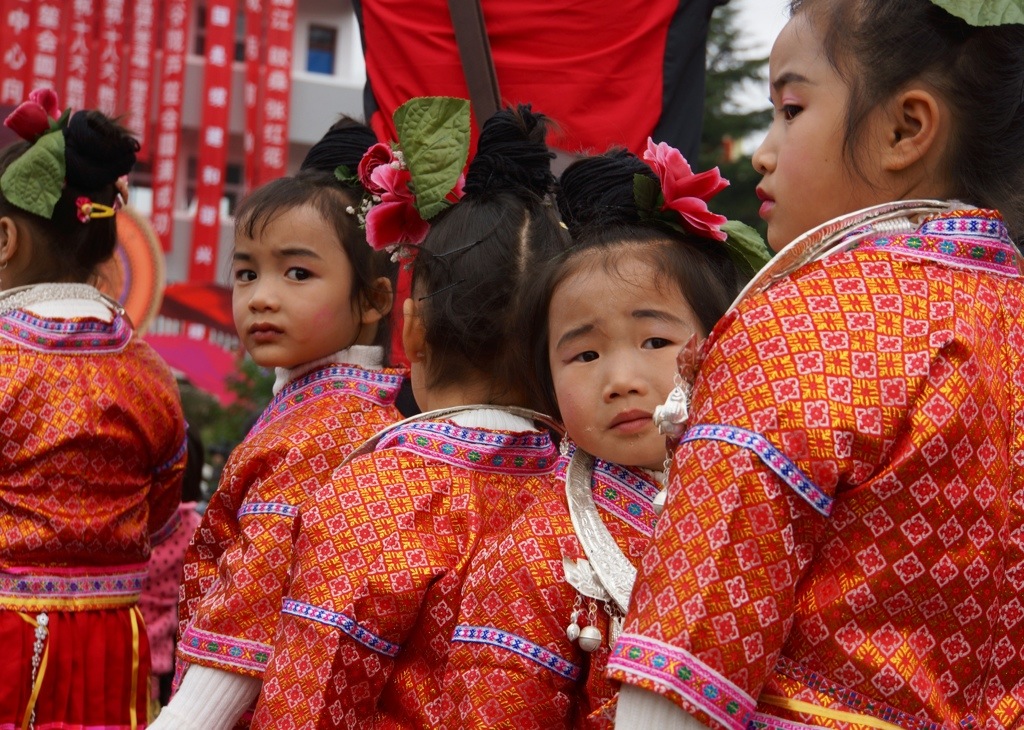
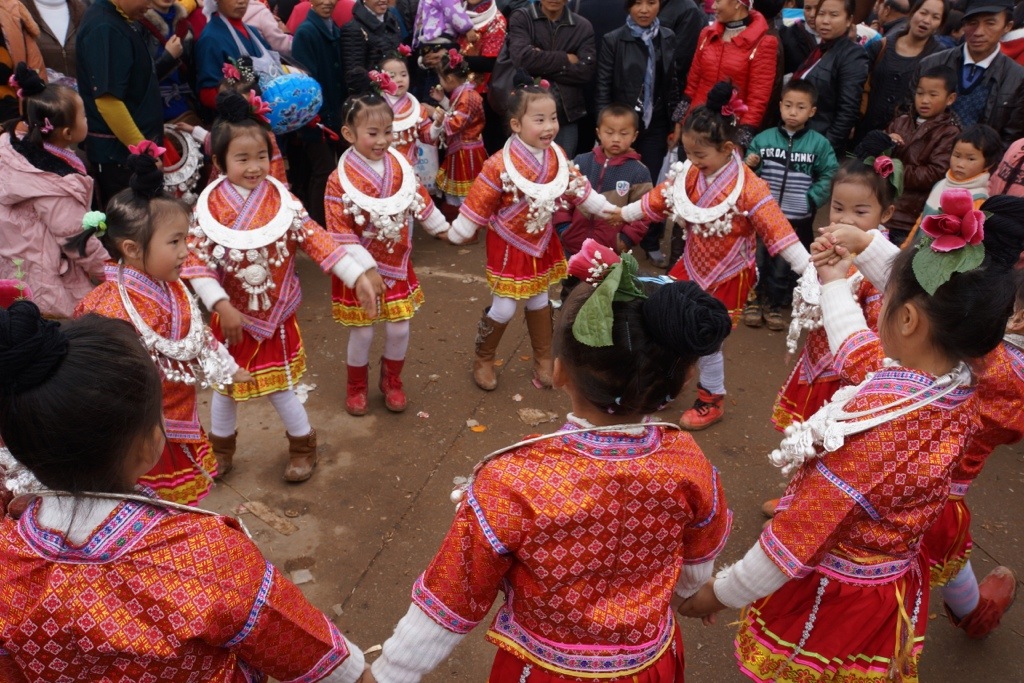
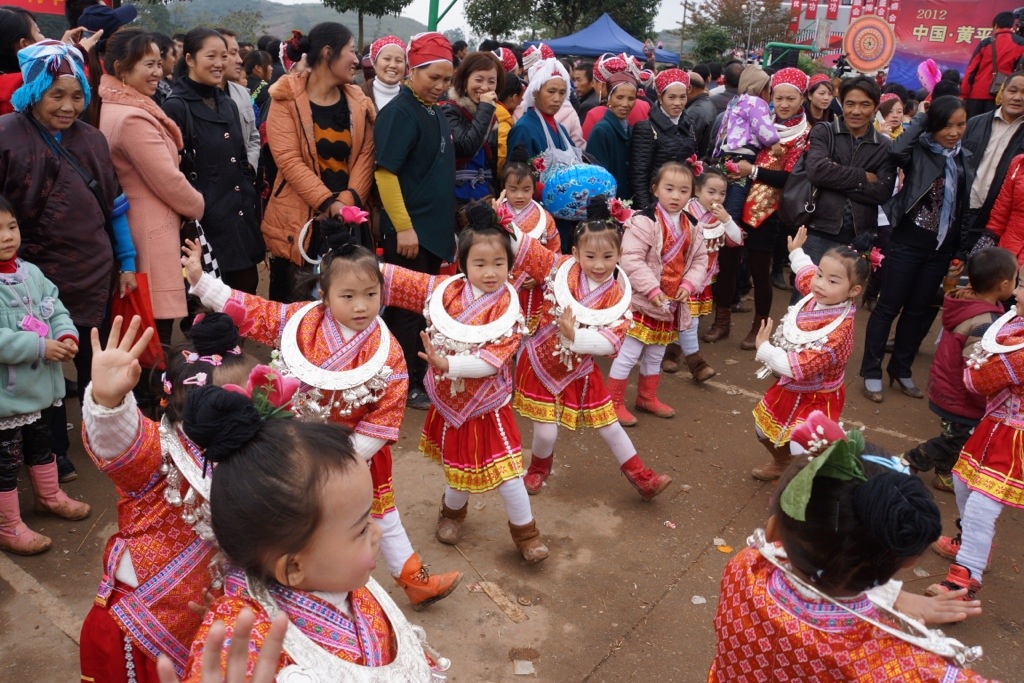
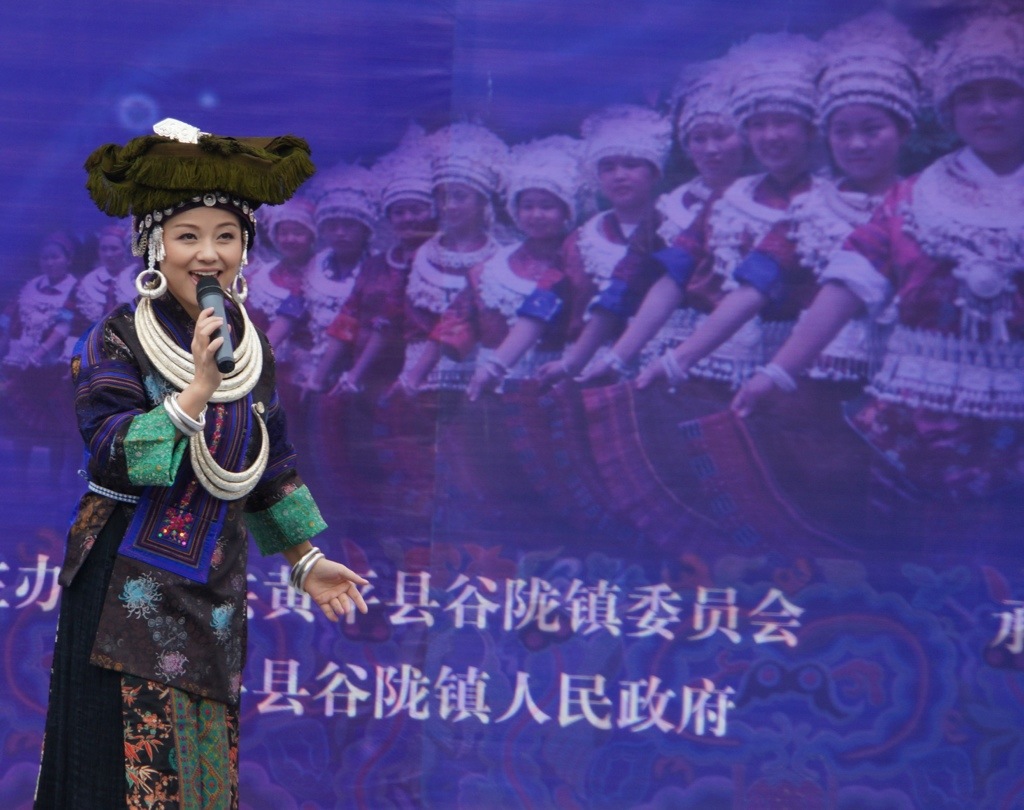
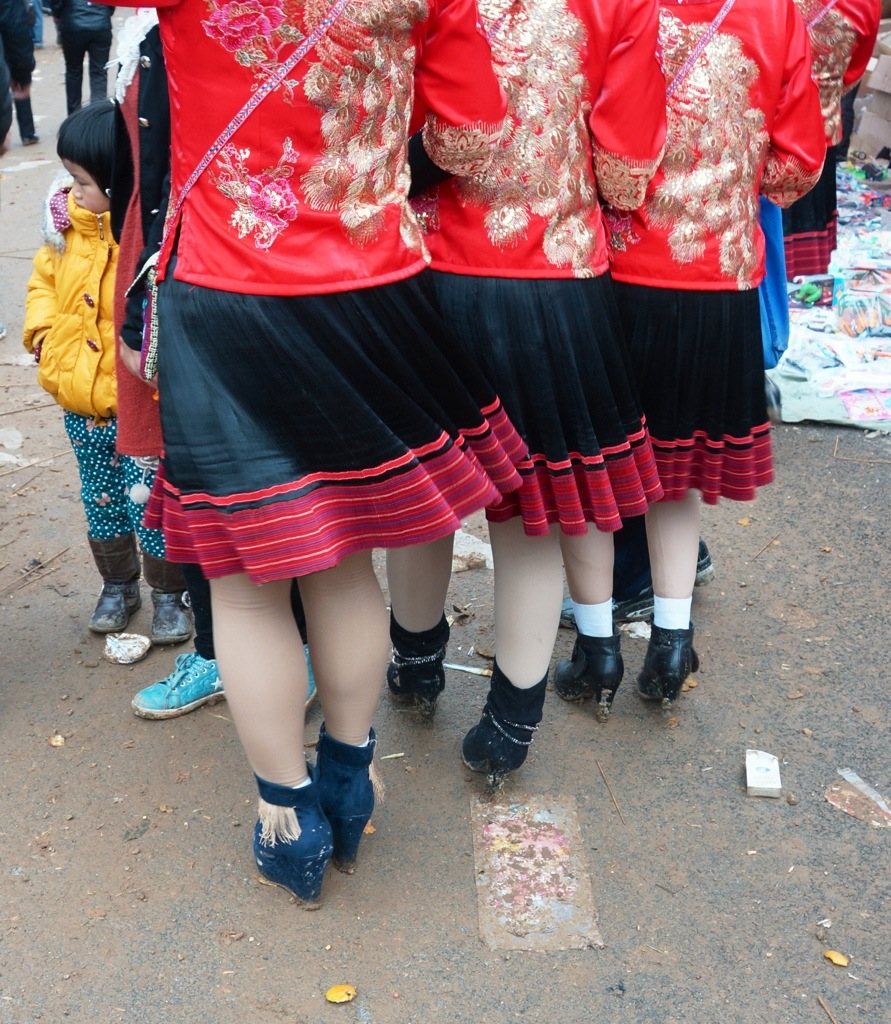
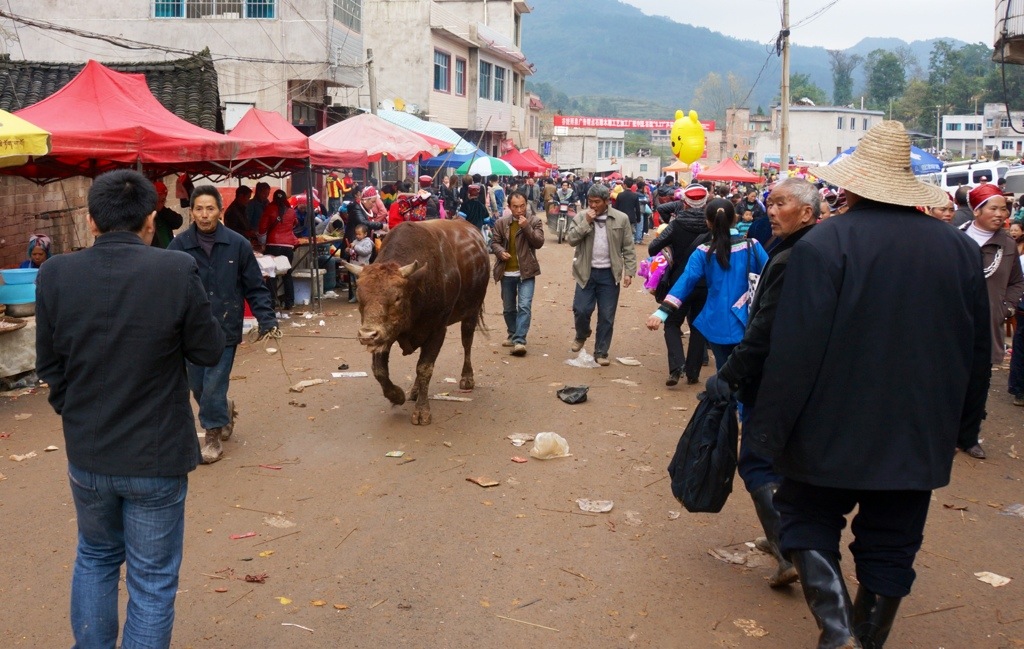
After two and a half hours, hike back up the hill to our bus and make our way through heavy traffic back to our hotel. Forty-five minutes to clean up then down for dinner at the hotel. Nevada has brought along a big stash of chocolates, and every night passes them around after dinner. I’ve gotten addicted.
|
|














































